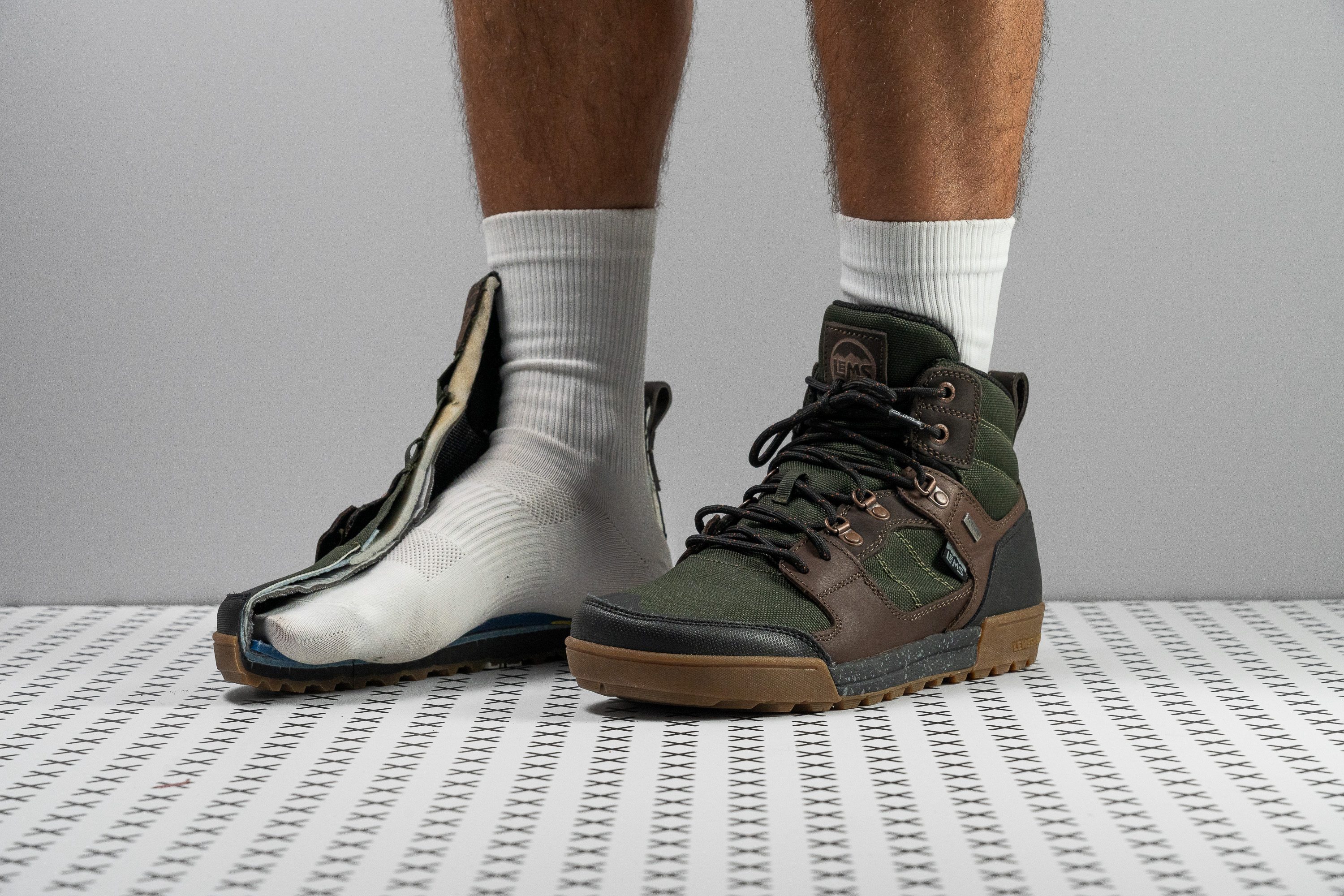Our verdict
Pros
- Minimal design promotes more natural underfoot experience
- Spacious foot-shaped fit
- Perfect all-season waterproof boot
- Superior grip on varied terrain
- Tougher than it looks
- Lighter than the average boot
- Very stable platform
- Comfortable ergonomic insole
- Flexible and unrestricting build
Cons
- Not a true Zero-Drop (8 mm!)
- Stack height deviates from specs
Audience verdict
- Top 5% in hiking boots
- Top 1% in Lems hiking boots
Comparison
The most similar hiking boots compared
+ + Add a shoe | |||||
|---|---|---|---|---|---|
| Audience score | 92 Superb! | 90 Great! | 87 Great! | 85 Great! | |
| Price | £190 | £200 | £130 | £170 | |
| Trail terrain | LightModerate | LightModerate | Light | Moderate | |
| Shock absorption | - | Low | Moderate | - | |
| Energy return | - | Low | Moderate | - | |
| Weight lab Weight brand | 15.3 oz / 434g | 17 oz / 482g 17 oz / 482g | 15.5 oz / 439g 15.7 oz / 444g | 18.2 oz / 515g 17.4 oz / 493g | |
| Lightweight | ✓ | ✓ | ✓ | ✗ | |
| Breathability | Warm | Warm | Warm | Warm | |
| Use | Day HikingLight HikingUrban hiking | Day HikingLight HikingUrban hiking | Light HikingUrban hikingBeginners | BackpackingDay HikingLight Hiking | |
| Orthotic friendly | ✓ | ✓ | ✓ | ✓ | |
| Drop lab | 8.1 mm | 13.5 mm | 12.3 mm | 12.9 mm | |
| Size | Half size small | True to size | True to size | True to size | |
| Midsole softness | Balanced | Firm | Soft | Firm | |
| Difference in midsole softness in cold | Small | Small | Normal | Small | |
| Heel counter stiffness | Flexible | Stiff | Flexible | Flexible | |
| Stiffness | Flexible | Moderate | Flexible | Moderate | |
| Outsole hardness | Average | Very hard | Average | Soft | |
| Waterproofing | Waterproof | Waterproof | Waterproof | Waterproof | |
| Material | LeatherTextile | Suede | Textile | Leather | |
| Season | Winter | Winter | Winter | Winter | |
| Toebox durability | Decent | Decent | Bad | Good | |
| Heel padding durability | Decent | Decent | Decent | Decent | |
| Outsole durability | Bad | Decent | Decent | Bad | |
| Width / fit | Wide | Medium | Narrow | Wide | |
| Toebox width | Wide | Medium | Narrow | Wide | |
| Lug depth | 3.5 mm | 3.7 mm | 3.0 mm | 4.2 mm | |
| Heel stack lab | 28.9 mm | 32.7 mm | 31.5 mm | 31.1 mm | |
| Forefoot | 20.8 mm | 19.2 mm | 19.2 mm | 18.2 mm | |
| Widths available | Normal | Normal | Normal | NormalWide | |
| Technology | - | Ortholite | - | Ortholite | |
| Cut | Mid cut | Mid cut | Mid cut | Mid cut | |
| Removable insole | ✓ | ✓ | ✓ | ✓ | |
| Ranking | #2 Top 5% | #8 Top 20% | #17 Top 42% | #25 Bottom 39% | |
| Popularity | #31 Bottom 24% | #32 Bottom 21% | #28 Bottom 31% | #23 Bottom 43% |
Who should buy
The Lems Outlander should be on your radar if you are looking for the following:
- minimalist hiking boots with a lower drop/stack and a more flexible build
- outdoor footwear with plenty of toe space
- an all-season waterproof boot
- a stylish boot with an earthy design (not too athletic-looking)
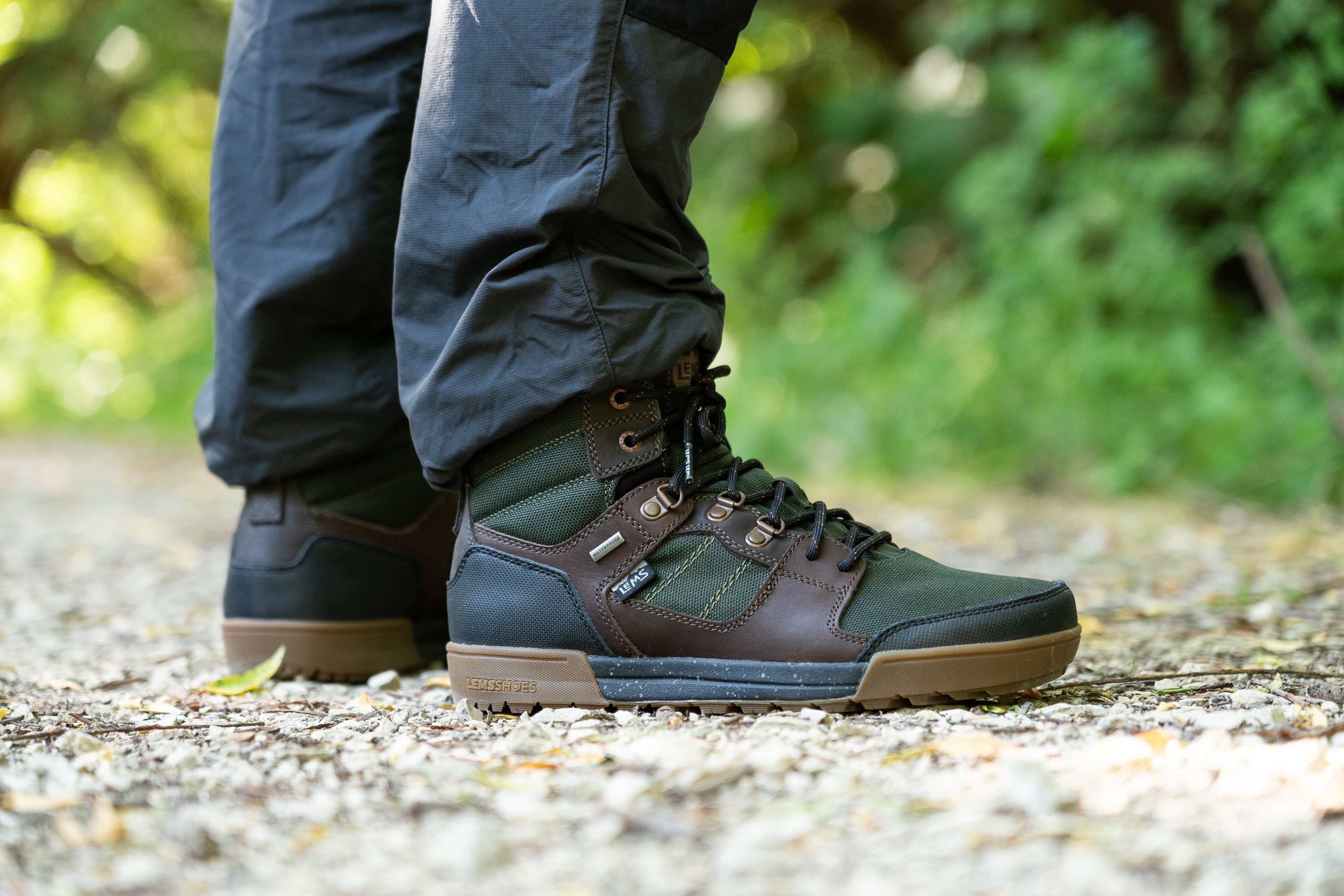
Who should NOT buy
People who specifically look for minimal boots with a 0 mm heel-to-toe drop will be disappointed with the 8-mm reading of our calliper.
We recommend considering the Altra Lone Peak Hiker 2 instead. Our measurements confirmed a 2.6 mm drop in that boot.
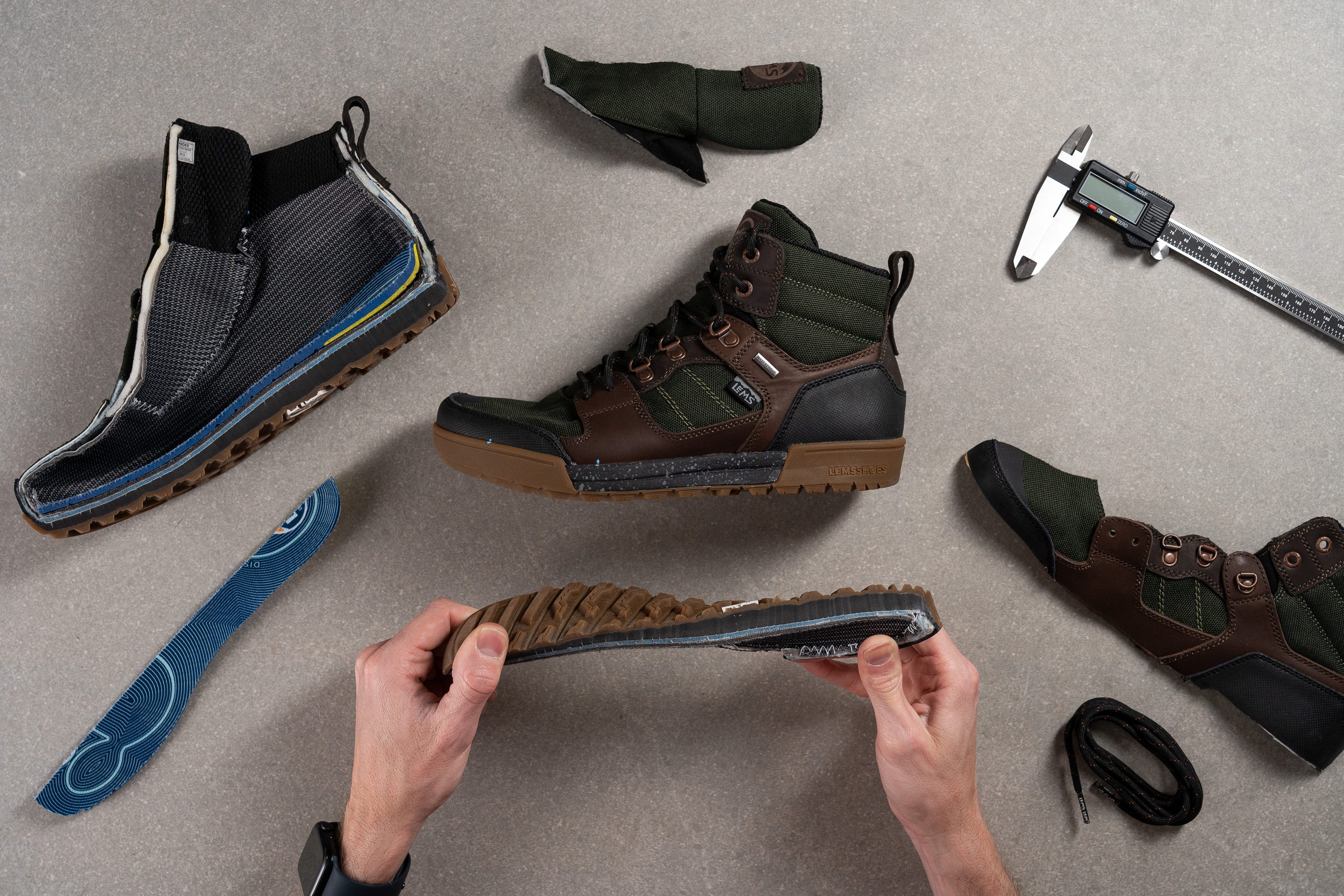
Cushioning
Heel stack
Lems is dedicated to making footwear that feels as natural as possible on foot. That's why you will find thinner, more grounded soles on the brand's hiking boots. And on paper, the Outlander is supposed to have only 16 mm of stack height.
But we found it to be far from the truth in our own measurements!
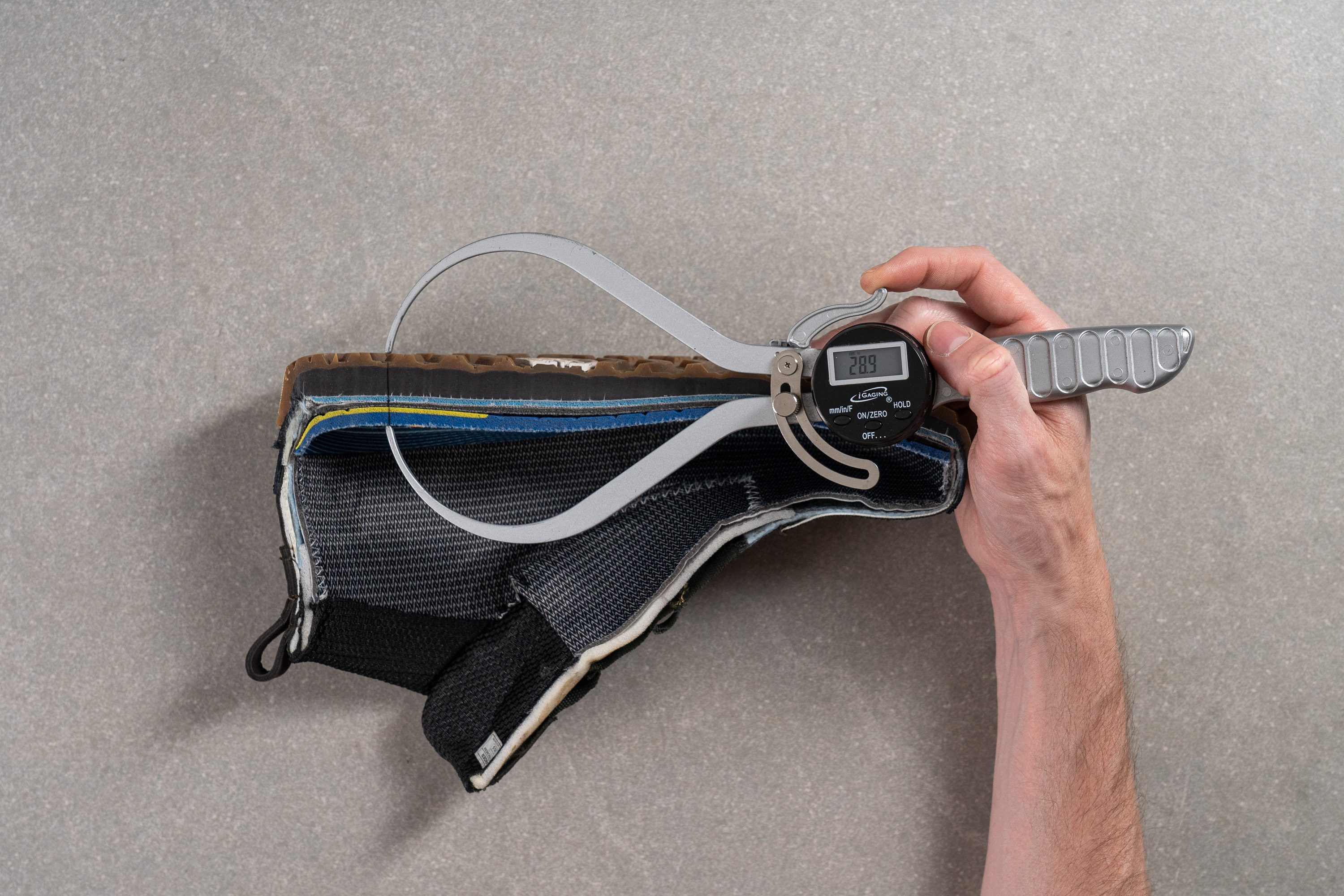
Checking the boot's heel stack, our calliper showed a whopping 28.9 mm! Even if we subtract the insole (7.2 mm) and the lugs (3.6 mm), it still leaves us with 18.1 mm. That's why we are not really sure what Lems implies by stack height considering that it is supposed to be the amount of material between the foot and the ground.
What is true, however, is the fact that the Outlander has some of the thinnest soles in our catalogue. It is only second to the Altra Lone Peak Hiker 2 (26.4 mm).
But even though the ground feedback is on the sensitive side, we received enough underfoot protection to feel surefooted in this Lems boot.
| Outlander | 28.9 mm |
| Average | 36.3 mm |
Forefoot stack
As for the boot's forefoot stack height, our calliper returned 20.8 mm. This is again thicker than the officially stated 16 mm and is on par with the hiking boot average.

The balls of our feet felt safeguarded from all the sticks and stones while enjoying the benefit of natural foot flexibility. The higher-stacked boots are much harder to bend in the forefoot in return for enhanced protection.
| Outlander | 20.8 mm |
| Average | 23.0 mm |
Drop
Warning: This is NOT a Zero-Drop boot!
The biggest discrepancy we discovered about the Lems Outlander is in its stated vs. measured heel-to-toe drop. According to the brand's product specs, there should be a 0-mm difference in height between the heel and the toes.
However, our calliper measurements revealed that the offset is MUCH greater than that - it is a whole 8 mm higher!

For some people, it can be a real deal-breaker while others may not even notice the difference between a 0-mm and 8-mm drop. But we are here to point out such inconsistencies.
We should also emphasise that even the boot's higher-than-expected drop of 8 mm is still lower than the industry average of 14 mm.
| Outlander | 8.1 mm |
| Average | 13.3 mm |
Midsole softness
Lems' approach to footwear doesn't involve plush cushioning either. There should be as little distortion in the foot's contact with the ground as possible. And the Outlander kept our underfoot experience pretty firm.
Using a Shore A durometer, we measured the boot's midsole foam at 30.0 HA. It is not the firmest midsole we've come across in a hiking boot (hello, Danner!) but it is in the firmest range for sure.
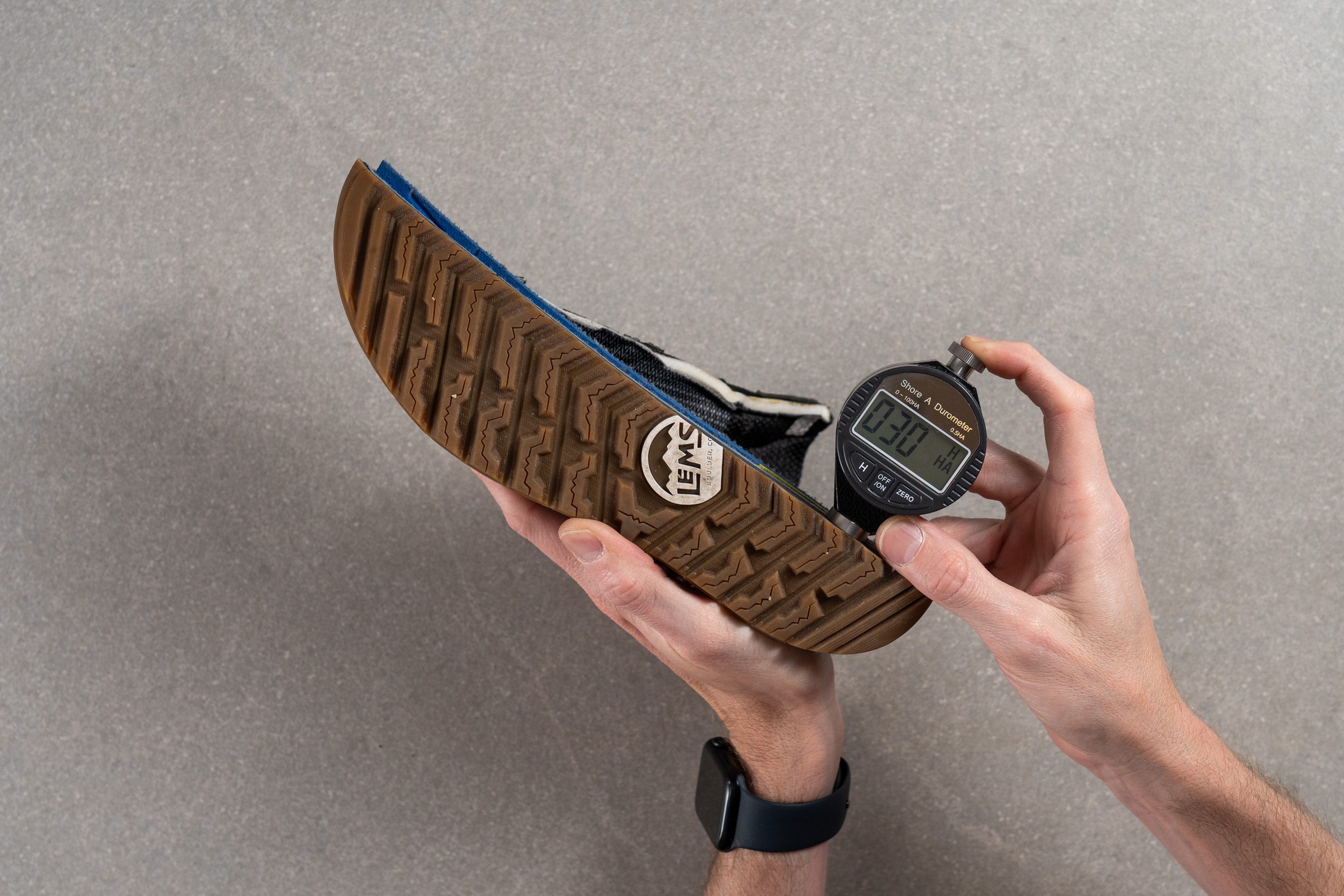
Less cushioning translates to better balance and a more "raw" contact with the hiking surface.
| Outlander | 30.0 HA |
| Average | 28.4 HA |
Size and fit
Size
Lems Outlander fits half size small (14 votes).
Consider sizing up
Internal length
Getting the Lems Outlander in our regular men's size 9, we were surprised that it ran somewhat short for our feet (263 mm).
According to Lems' shoe size chart, there should be 268 mm of insole length in their US size 9 boots but our own measurement showed a smaller reading of 261.7 mm.
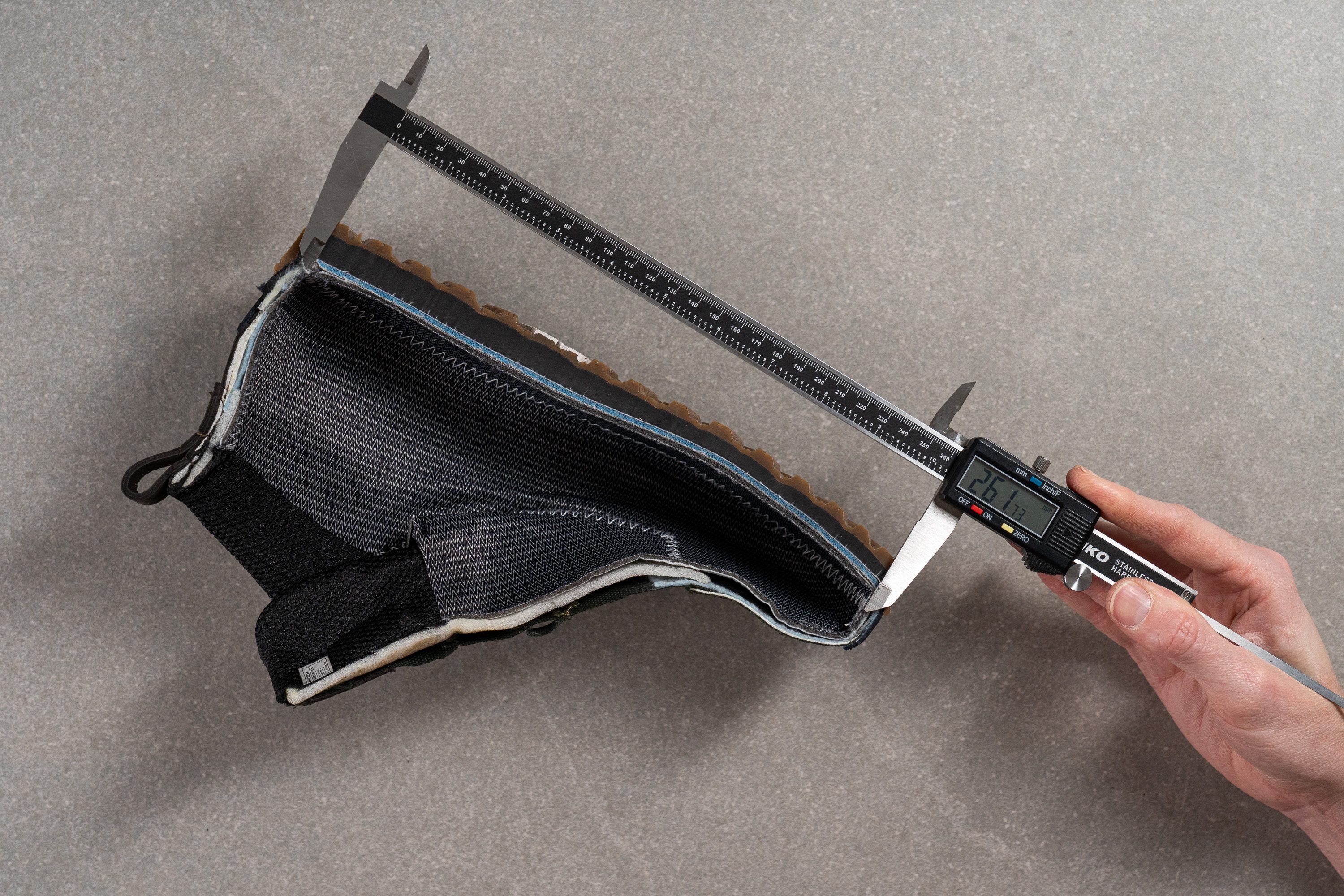
Adding to the confusion, the brand recommends getting "your normal US size" for the Outlander on their website.
We would have to disagree with that and advise going at least half a size up in this Lems boot. Or even a full US size up if you're planning to wear thicker woollen socks.
| Outlander | 261.7 mm |
| Average | 271.4 mm |
Toebox width - widest part
Even though the Outlander runs a bit small length-wise, it certainly doesn't lack space in the toebox. Lems preaches foot health by designing foot-shaped footwear that never squeezes toes and leaves plenty of room for comfortable toe-splay.
Lems offers three types of fit (Medium, Wide, and Widest) and the Outlander features a middle-of-the-road Wide Natural-Shape Fit.
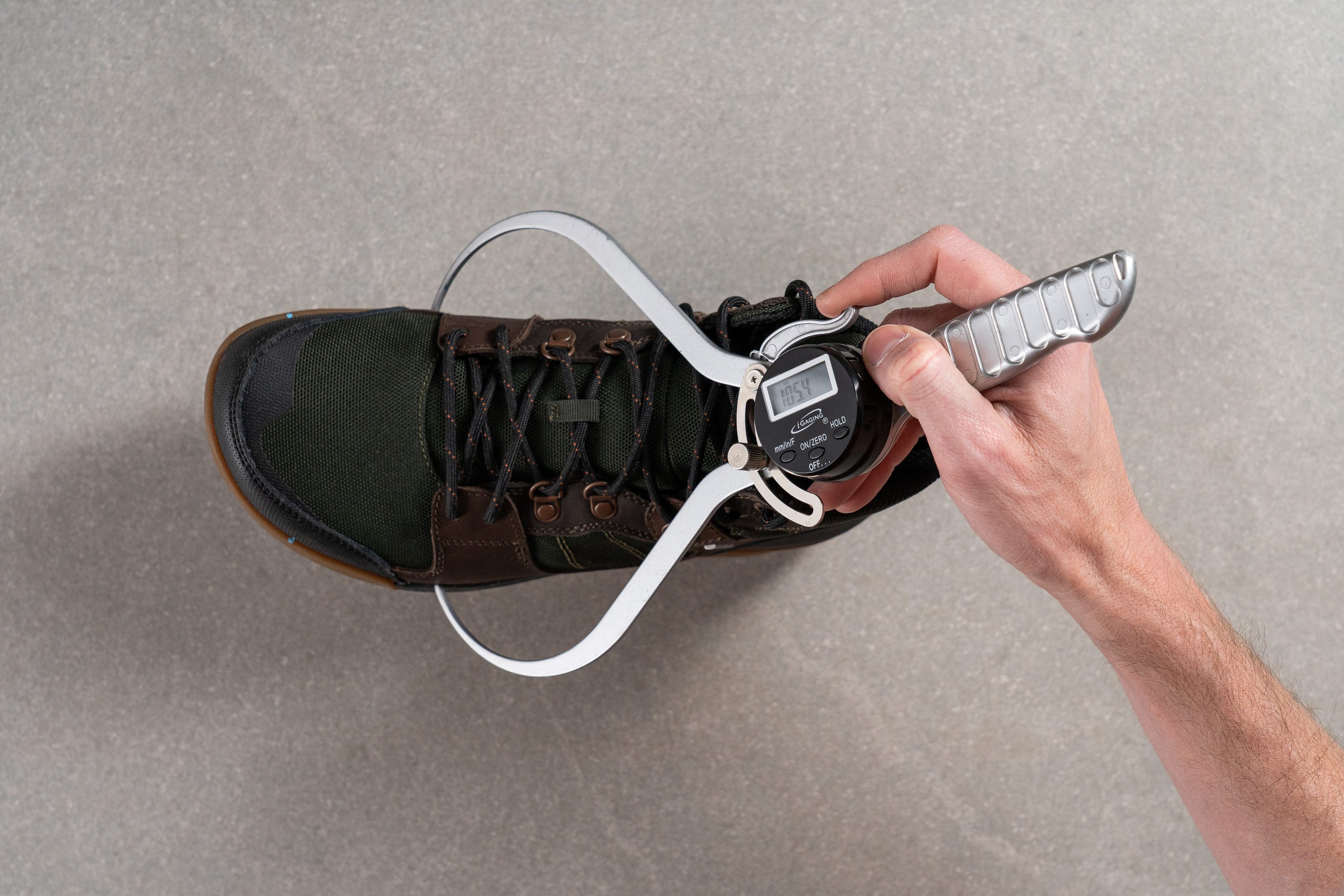
Measuring its widest area with a caliper, we got a bigger-than-average reading of 105.4 mm. We can recommend this hiking boot to folks with wide feet without hesitation.
This test follows an older methodology, which is why you don't see recently tested shoes in the chart. Results from different methodologies can not be compared.
| Outlander | 105.4 mm |
| Average | 102.1 mm |
Toebox width - big toe
But there's more! The Outlander's toebox remains wide and square even at the tip of the boot. Measuring the area near the big toe, our caliper showed 86.4 mm which is about 8(!) mm wider than average!
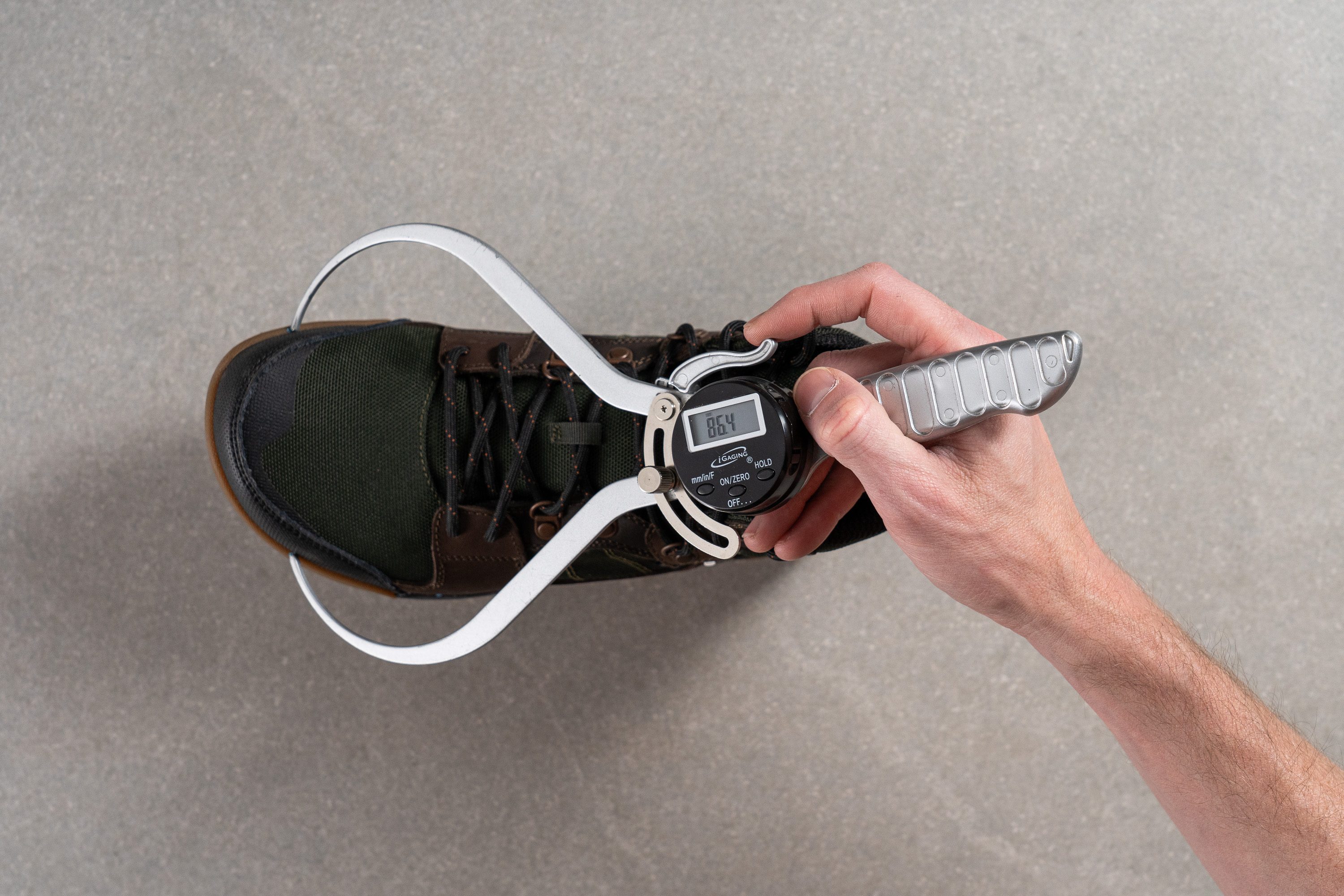
In addition to the toe freedom, we also experienced the benefit of achieving better balance by splaying our toes as much as we needed on rocky terrain.
This test follows an older methodology, which is why you don't see recently tested shoes in the chart. Results from different methodologies can not be compared.
| Outlander | 86.4 mm |
| Average | 78.6 mm |
Traction / Grip
Lug depth
Lems refers to the lugs of the Outlander as "serious tread" and states them to be 4 mm deep. Our own lab measurements showed 3.5 mm which is only half a millimetre off.
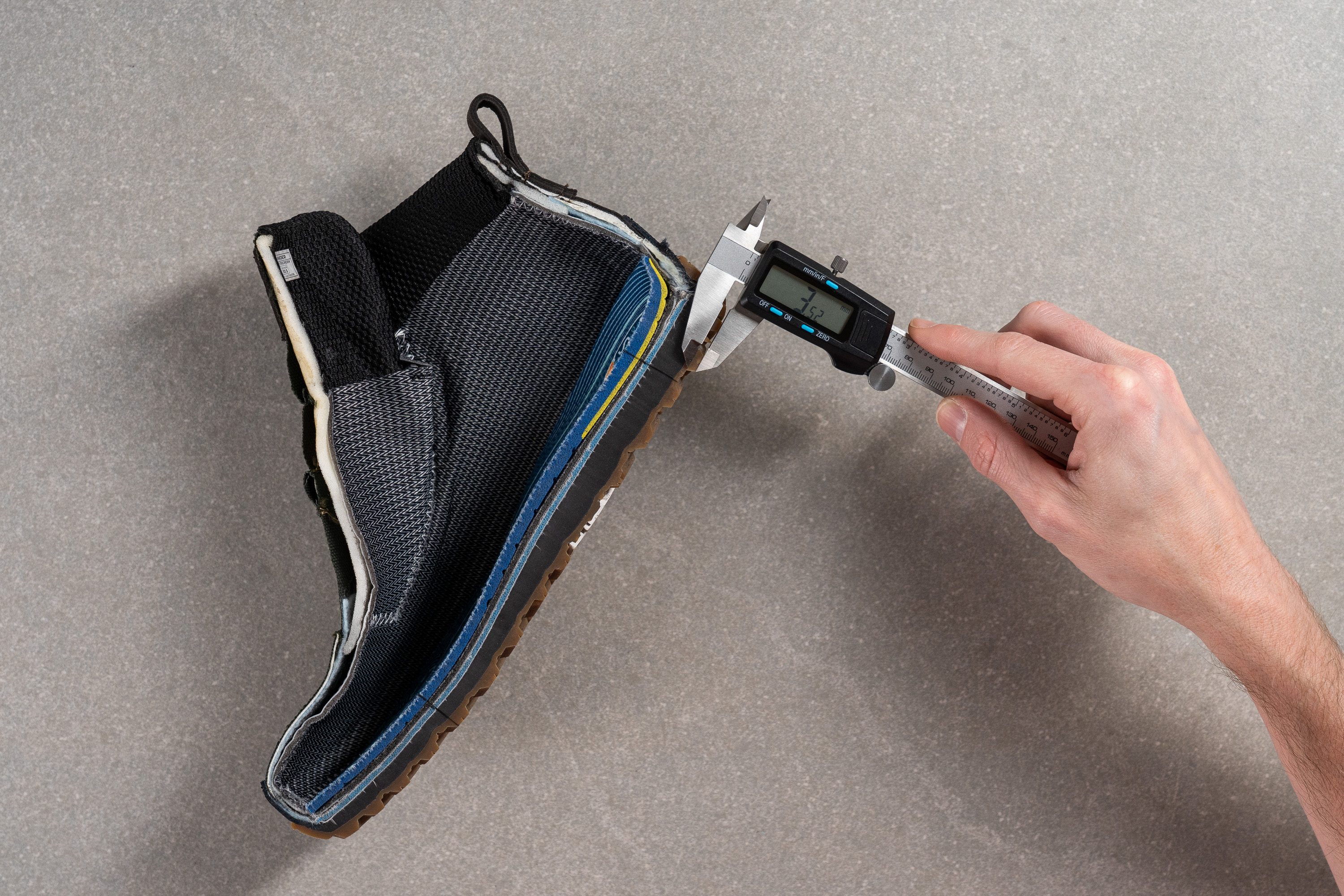
While these are not some of the deepest lugs we've recorded in our lab (those come in at 5-6 mm), we can confirm their effectiveness on muddy and snowy patches. However, if your primary hiking terrain is soft, you may want to go for the deeper lugs.
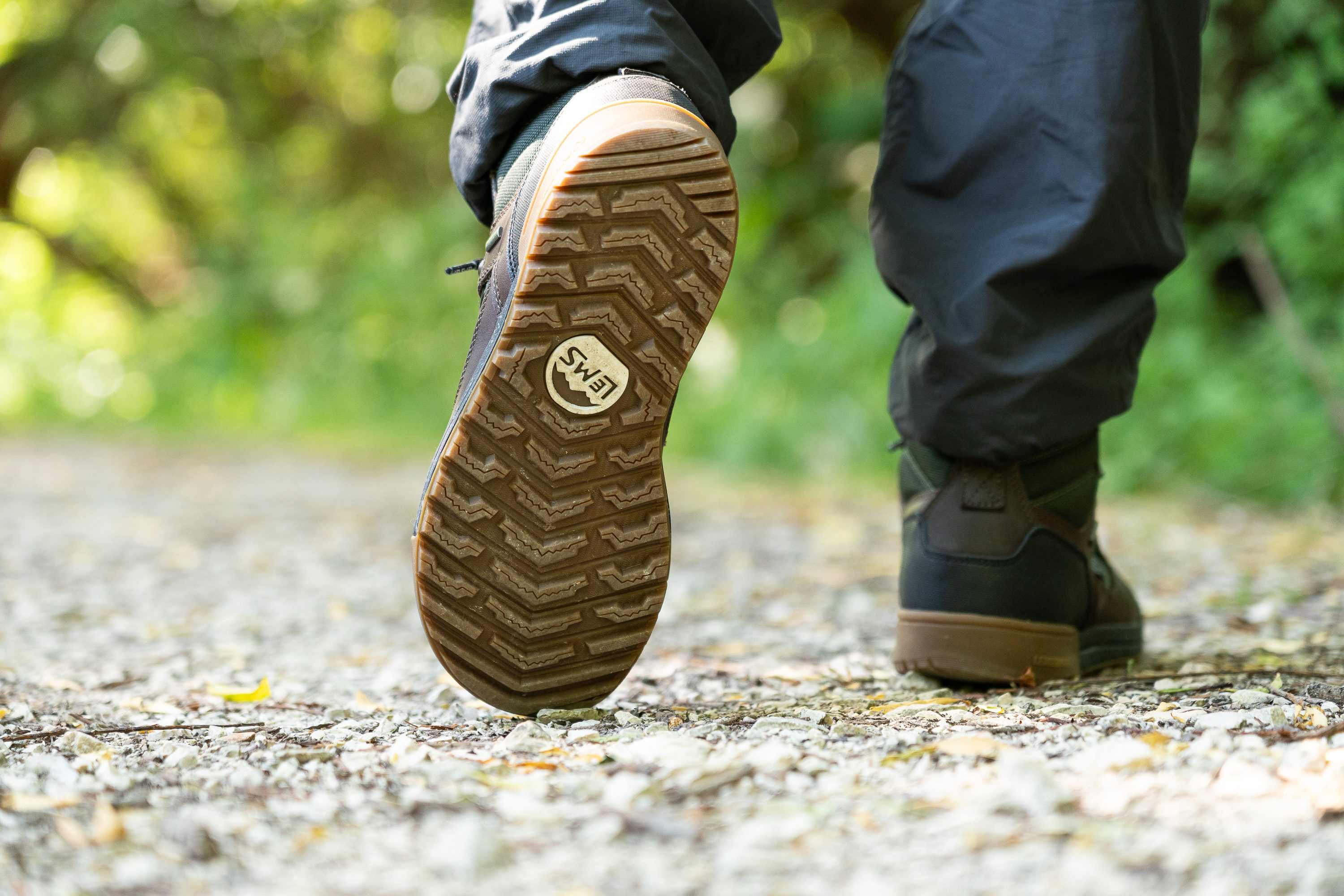
But for varied terrain which includes some boulder-hopping, some wet log climbing, and occasional encounters with moss, puddles, and slush, the Outlander's zig-zag treading is a reliable companion.
| Outlander | 3.5 mm |
| Average | 4.3 mm |
Flexibility / Stiffness
Its minimalist design made the Outlander one of the most flexible hiking boots we've tested.
It took as little as 22.8N to bend this Lems boot to a 90-degree angle, according to our gauge. 95% less than the average!
We loved the manoeuvrability it provided on technical terrain as the freedom of movement helped us be more precise with our foot placement on tricky patches. We even felt as if the extra flexibility improved the grip on rocks and boulders as we were able to "hug" the surface with our feet better which would not be possible in thick rigid boots.
This test follows an older methodology, which is why you don't see recently tested shoes in the chart. Results from different methodologies can not be compared.
| Outlander | 22.8N |
| Average | 44.3N |
Stiffness in cold (%)
But here is the caveat... Expect to lose some of this flexibility in low temperatures!
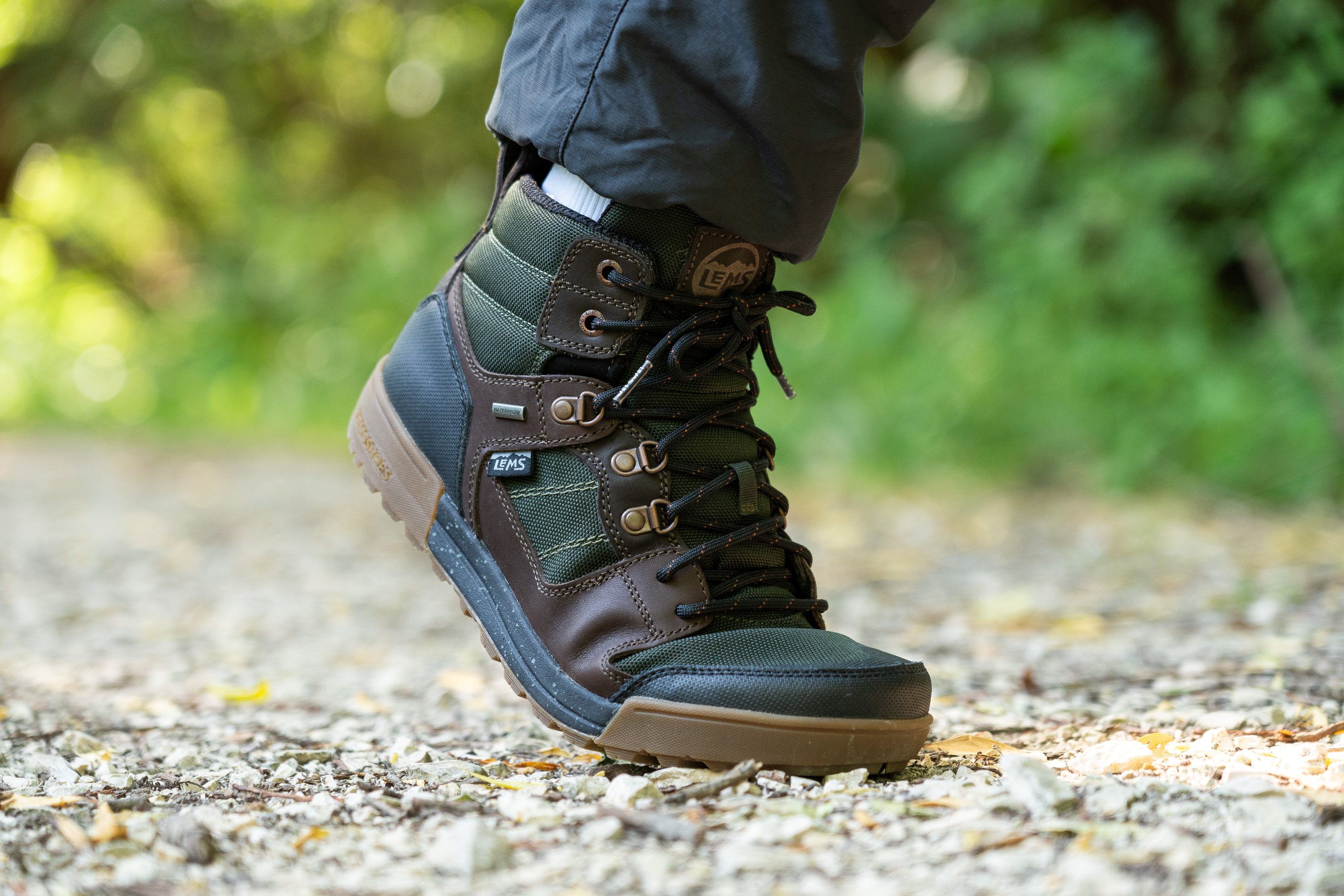
Having kept the Outlander in the freezer for 20 minutes, we were disappointed to see that the boot got 32.2% harder to bend.
On the bright side, even in its "frozen" condition, it remained more flexible than most hiking boots in normal conditions.
| Outlander | 32% |
| Average | 24% |
Weight
As a rather minimal hiking boot, the Lems Outlander keeps its weight on the lower side of the hiking footwear spectrum.
It checked in at a moderate 15.3 oz (434g) which is about 3.5 oz lighter than the average.
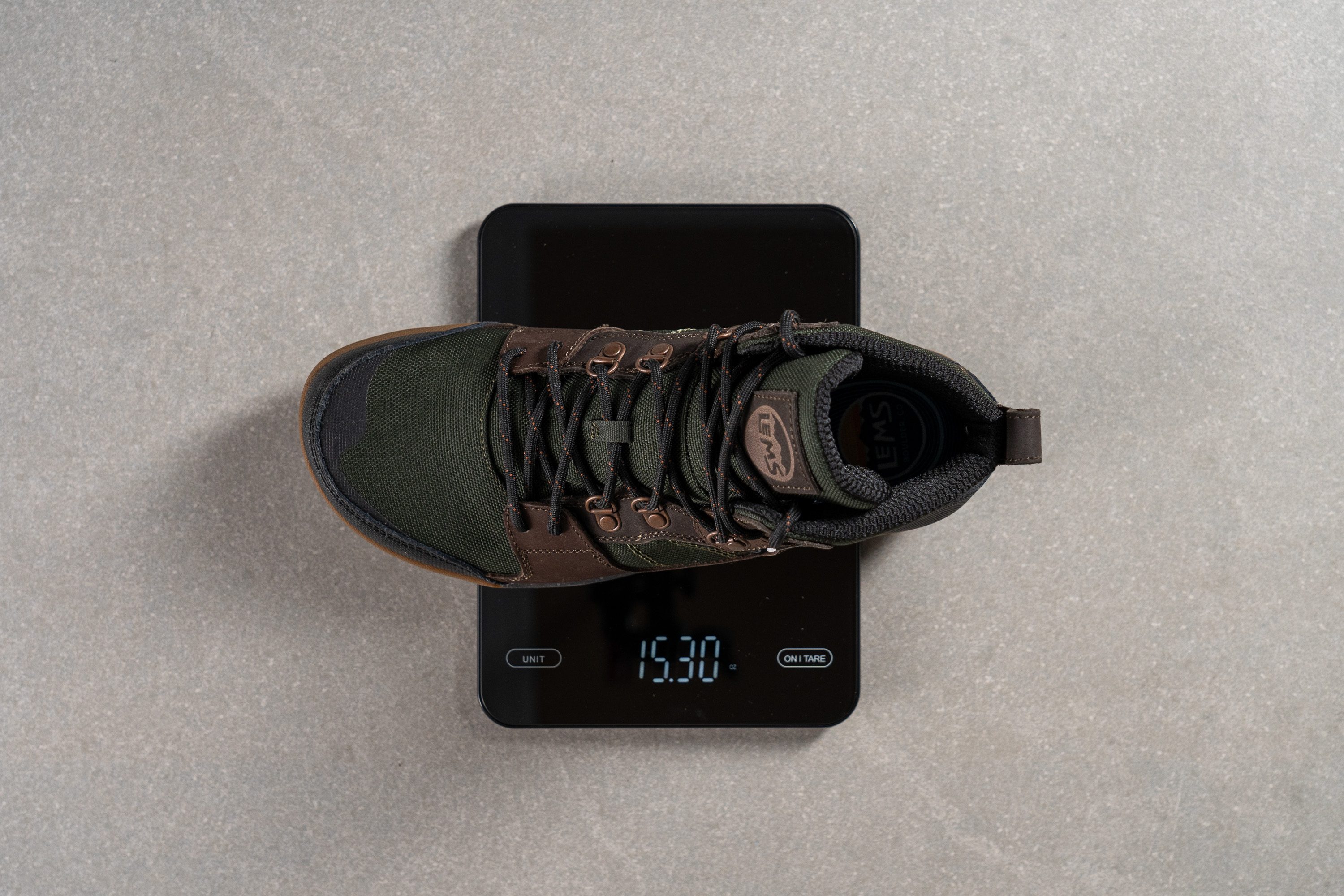
Surprisingly, it didn't make it to the lightest boots on our roster but it feels lighter than the scale suggests.
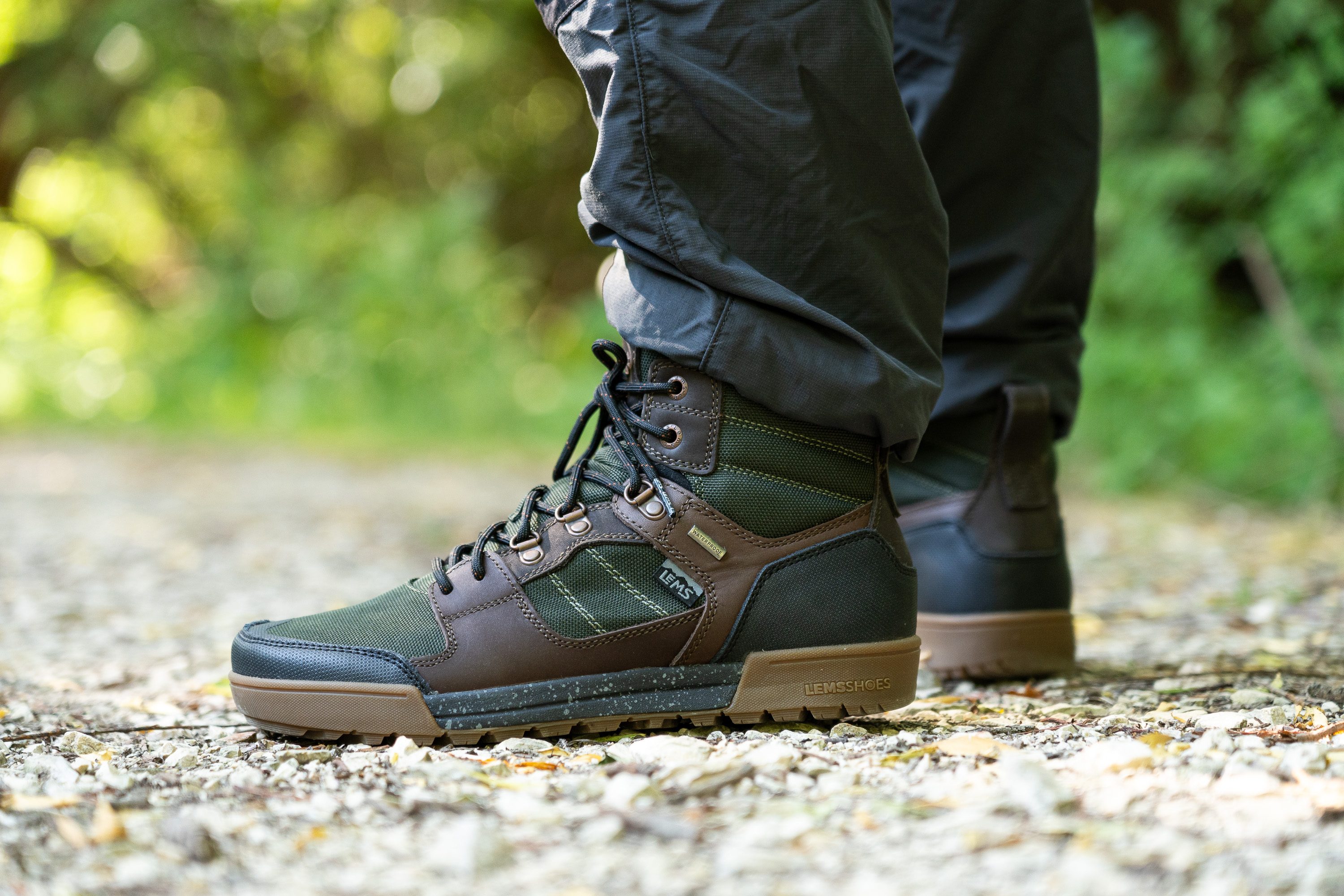
In our experience, the Outlander never dragged our feet down or made us crave to lose boots mid-hike.
| Outlander | 15.3 oz (434g) |
| Average | 18.7 oz (531g) |
Breathability
As a waterproof hiking boot, the Outlander doesn't feel particularly well-ventilated. Our smoke-pumping breathability test below is a pretty vivid illustration of the boot's airtightness.
Considering that not a single streak of smoke passed through the boot's nylon toebox, we easily rated its breathability with the lowest score of 1 out of 5.
In addition, the boot's nylon upper material is incredibly tightly woven. We couldn't see a single pore even through the microscope!
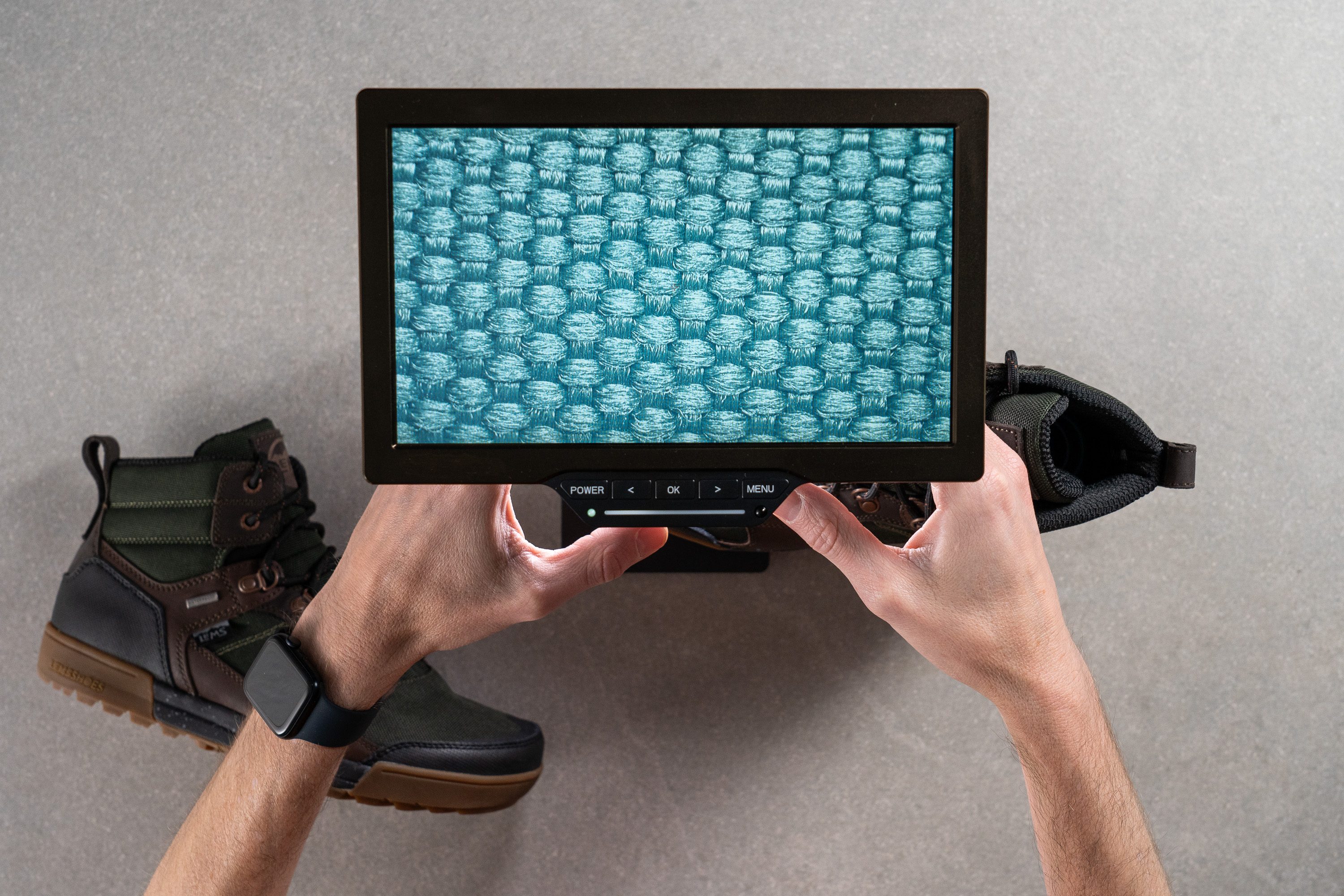
But on the upside, this dense fabric is perfect for keeping your feet dry and warm when challenging weather is innvolved.

| Outlander | 1 |
| Average | 1.3 |
Waterproofing
The Outlander uses the same waterproofing liner as the brand's famous Boulder Boot. This membrane doesn't have a name but gets the job done beautifully.
Downpours, creeks, and slush - the Outlander can handle them all! Extreme weather conditions aside, it is also a pretty versatile four-season boot. We found that with proper sock choice, this Lems boot can keep us comfortable in temperatures between 30°F (-1°C) and 70°F (21°C).
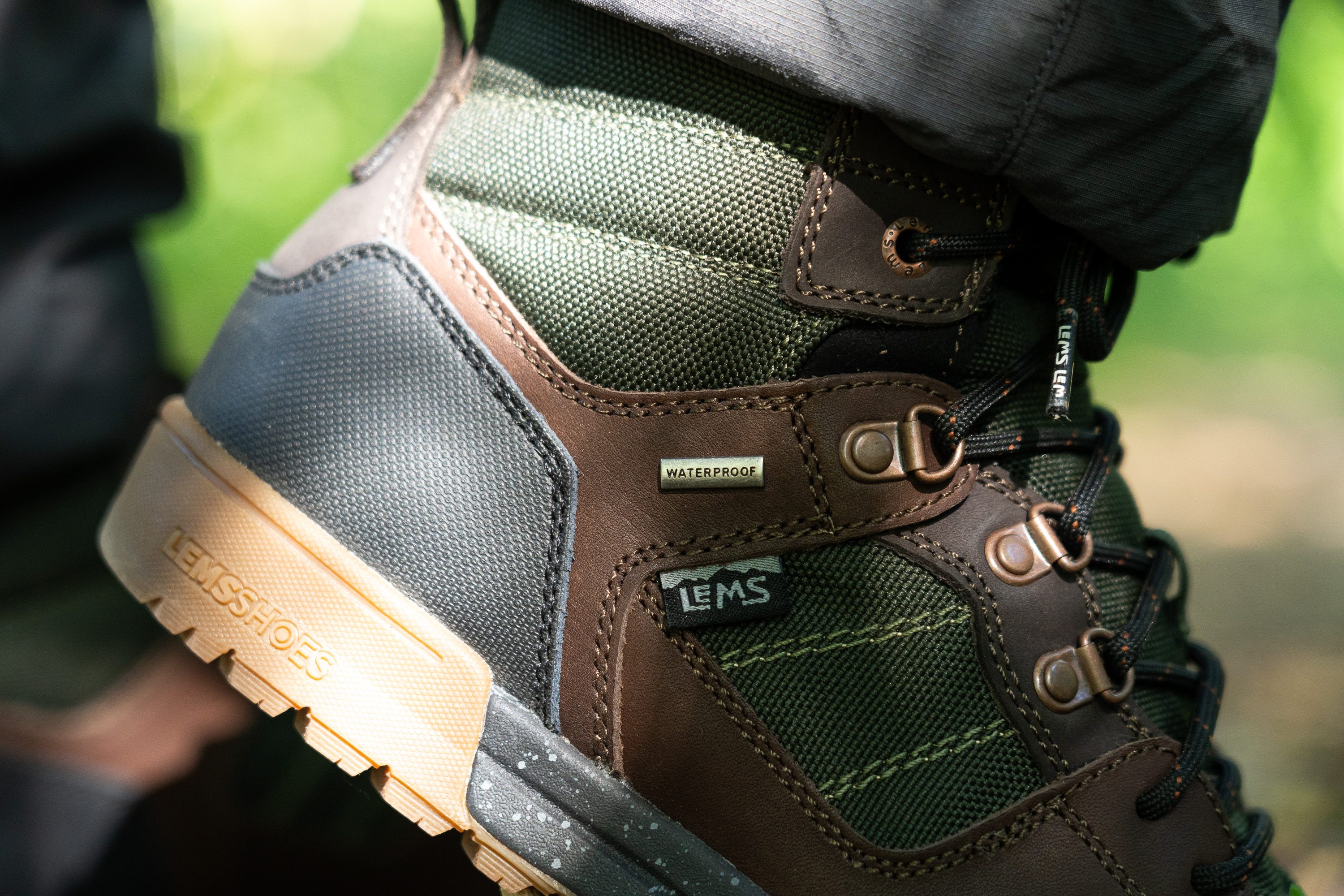
Lems also reminds wearers that the boot's waterproofing capacity can be extended as long as you:
- clean it regularly
- reapply waterproofing treatment
- store it properly (cool dry place)
- inspect seams and stitches every once in a while
Stability
Lateral stability test
The way Lems Outlander made us feel stable without any rigid stability components or bulky structure was quite impressive.
We never felt wobbly or tippy in the boot, even when the terrain got hilly and tricky. We assume that the boot's grounded and firm platform is the main source of stability in the Outlander.
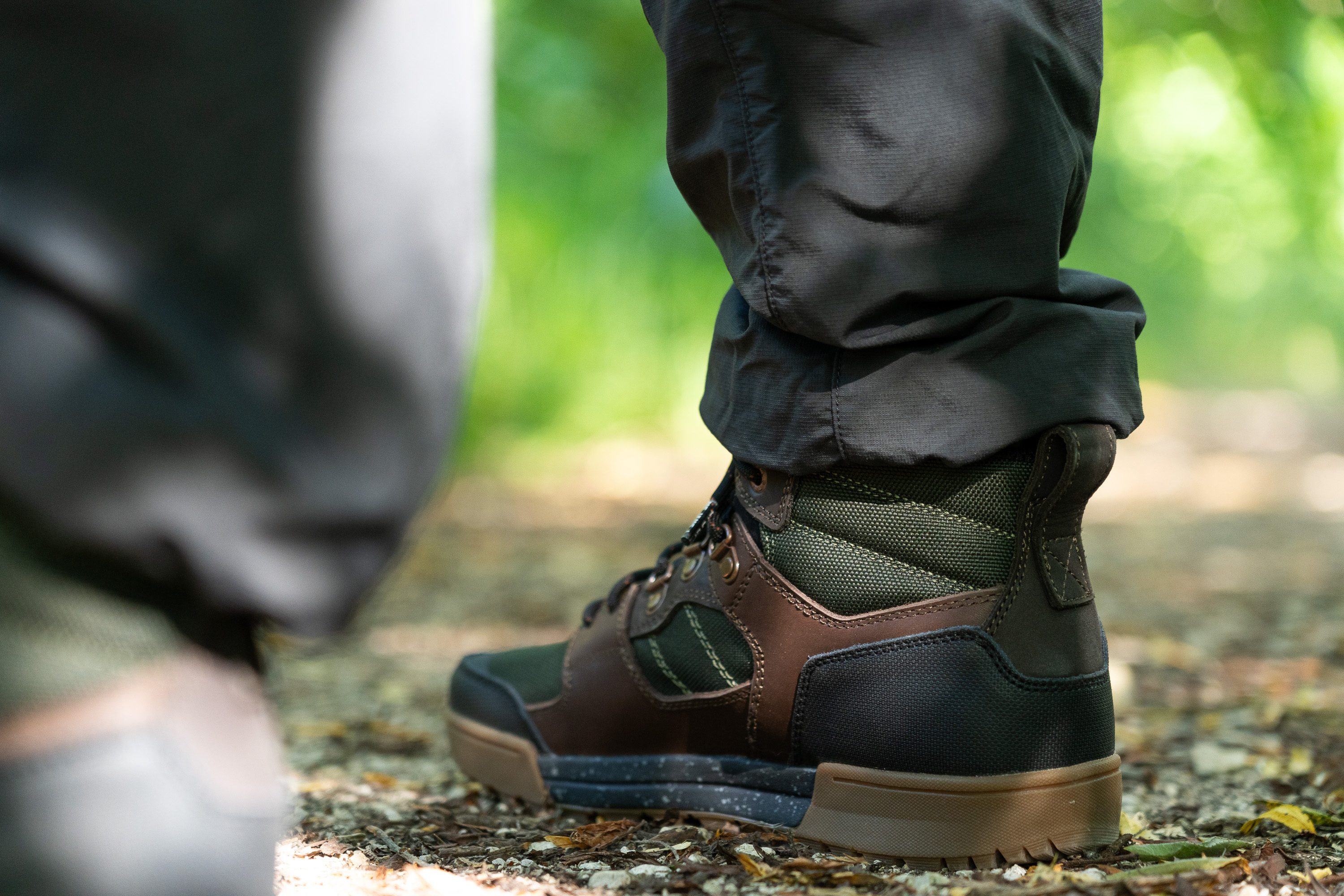
Torsional rigidity
The Outlander's simple design doesn't include any stiff shanks or other stabilising elements to prevent the foot from buckling. And yet, we never felt like the boot needed those!
It took very little effort to twist this Lems boot in our manual test. Thus, we rated its torsional rigidity with a lower score of 3 out of 5. This is considered flexible in the realm of hiking boots.
| Outlander | 3 |
| Average | 4.4 |
Heel counter stiffness
We felt no rigid clutch around our heels and ankles either.
A push-and-squeeze test also revealed the flexibility of the Outlander's heel counter. On a 1-5 stiffness scale, we also gave it a moderate score of 3.

Here we should note that such flexibility never resulted in our heels sliding inside or slipping outside of the boot. The backs of our feet remained securely in place while we enjoyed a less restrictive foothold of the Outlander.
| Outlander | 3 |
| Average | 3.6 |
Midsole width - forefoot
It seems like Lems embodies the concept of not adding more than necessary to its products.
We found that the sole dimensions of the Outlander do not exceed the average of hiking boots but we never lacked platform width to feel stable.
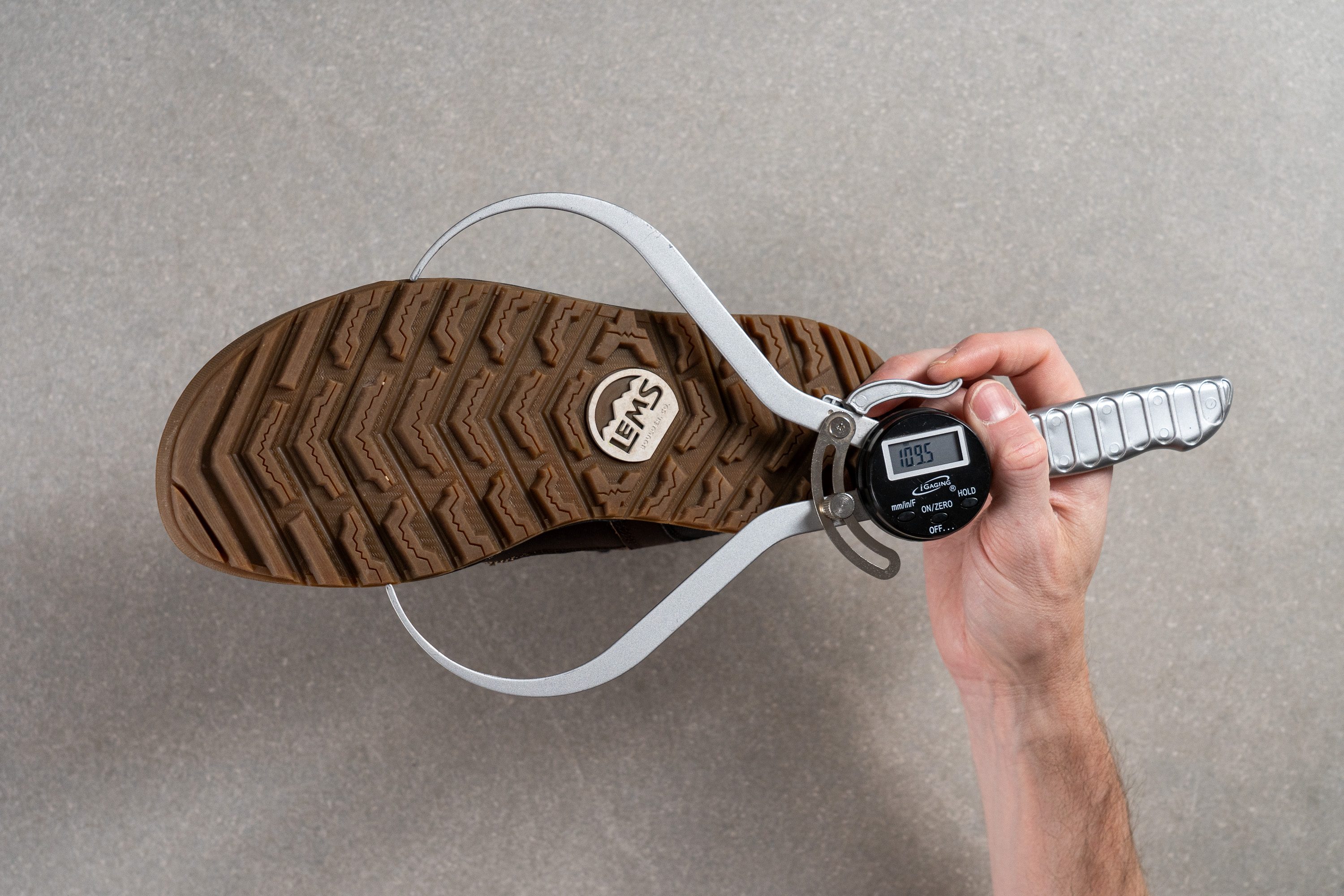
Measuring the widest area of the boot's sole, our calliper returned a slightly narrower-than-average width of 109.5 mm.
| Outlander | 109.5 mm |
| Average | 111.5 mm |
Midsole width - heel
The heel of the Outlander is notably narrower than the average at 82.4 mm. But, once again, this did not result in any wobbling or instability in the boot.
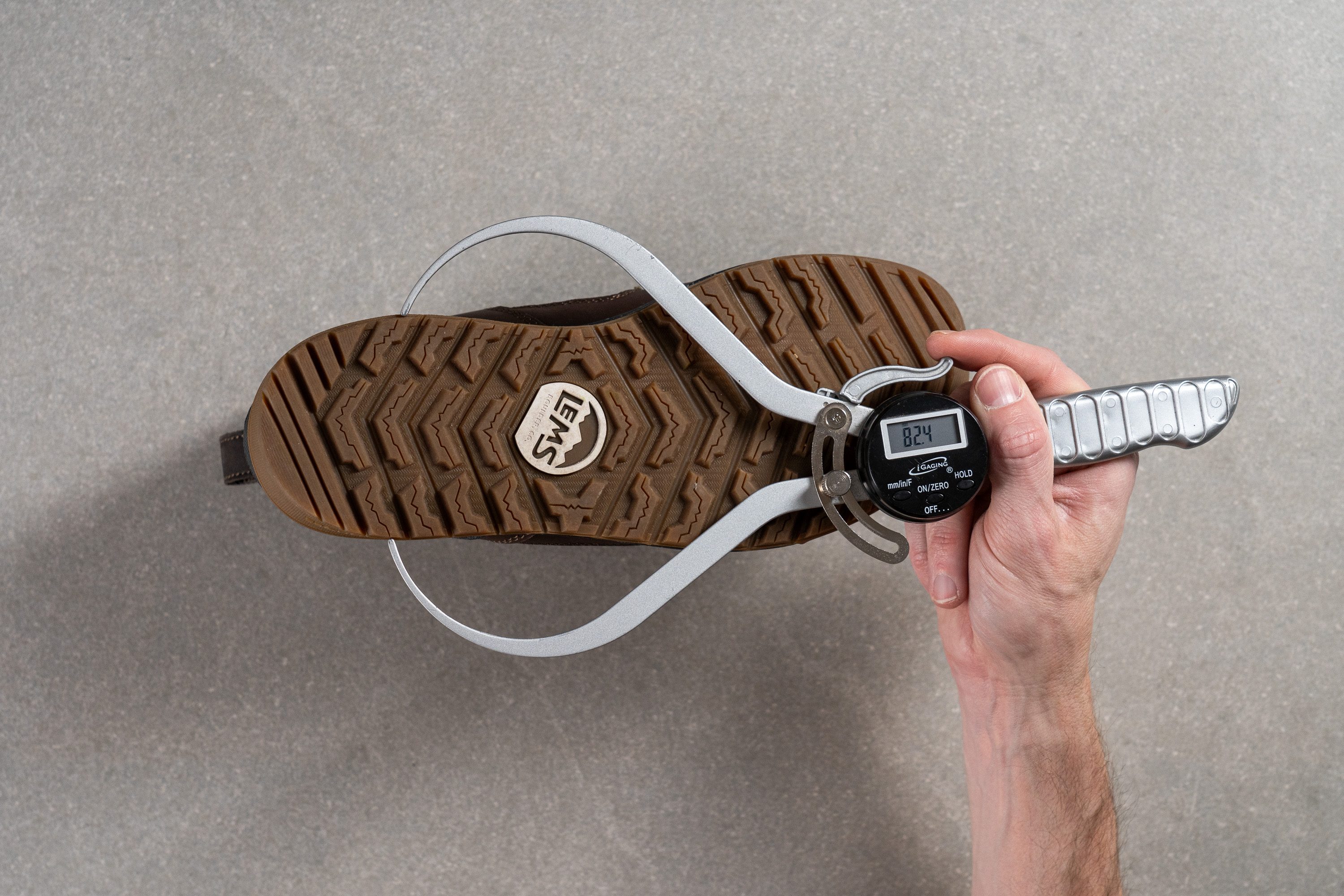
| Outlander | 82.4 mm |
| Average | 87.6 mm |
Durability
Toebox durability
The Outlander's upper design is fairly minimal compared to most hiking boots on the market. There is a solid forefoot reinforcement for bumping into rocks and roots but the top portion of the toebox has nothing but exposed nylon.
Let's see if that material is ready for slashes and brushes against trail debris.
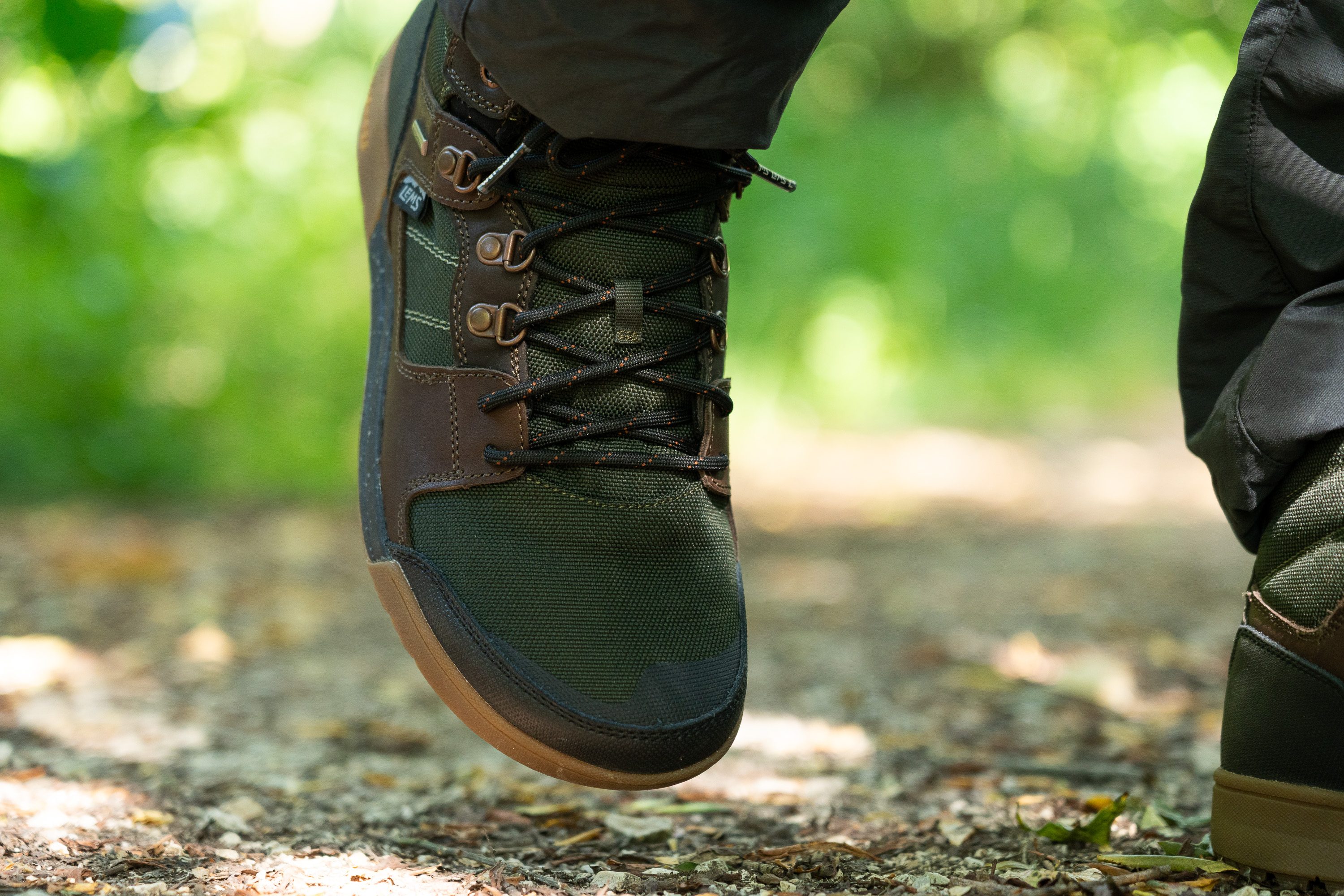
Equipped with a Dremel, we drilled the boot's toebox with sandpaper at 5K RPM speed and 3.2N pressure. After torturing the fabric for 12 seconds, we were happy to see that the nylon resisted the tool but the protective layer on top of it was completely gone. Thus, we had to lower the score slightly.
Earning 4 out of 5 for toebox durability, we can confirm that the Outlander's upper durability is on par with most hiking boots we've tested (and even better than some of them!).

| Outlander | 4 |
| Average | 4.3 |
Heel padding durability
Inside, the Outlander's collar is lined with a rather standard polyester fabric.
Giving it a 4-second sandpaper drill at 5K RPM speed, we nodded in approval once again. The textile got away from the Dremel without any major damage, earning this Lems boot another high durability score - 4 out of 5 for the heel padding longevity.
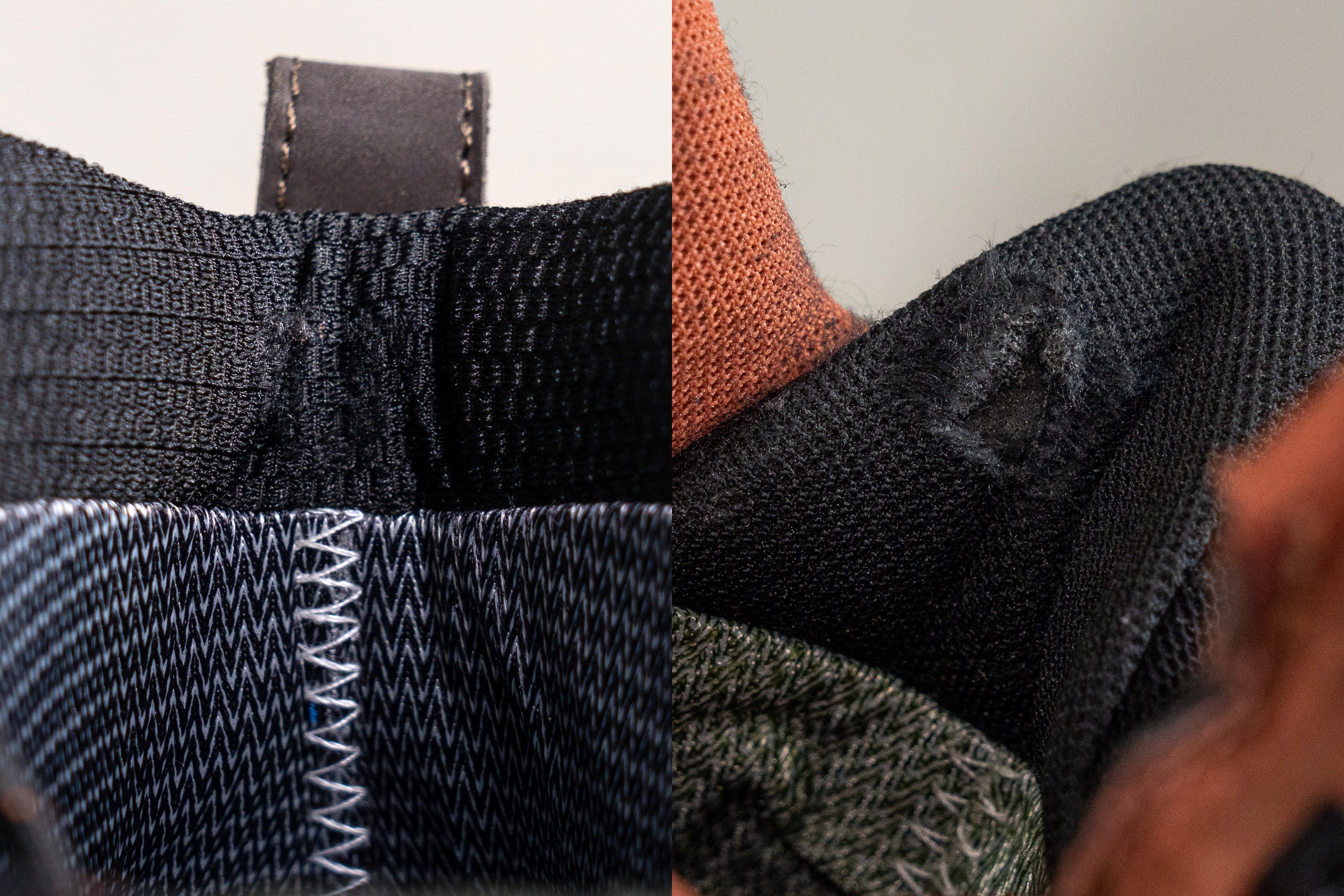
| Outlander | 4 |
| Average | 3.6 |
Outsole hardness
The Outlander uses a proprietary rubber compound for the outsole. It didn't seem particularly firm to us but it wasn't the soft and tacky kind either.
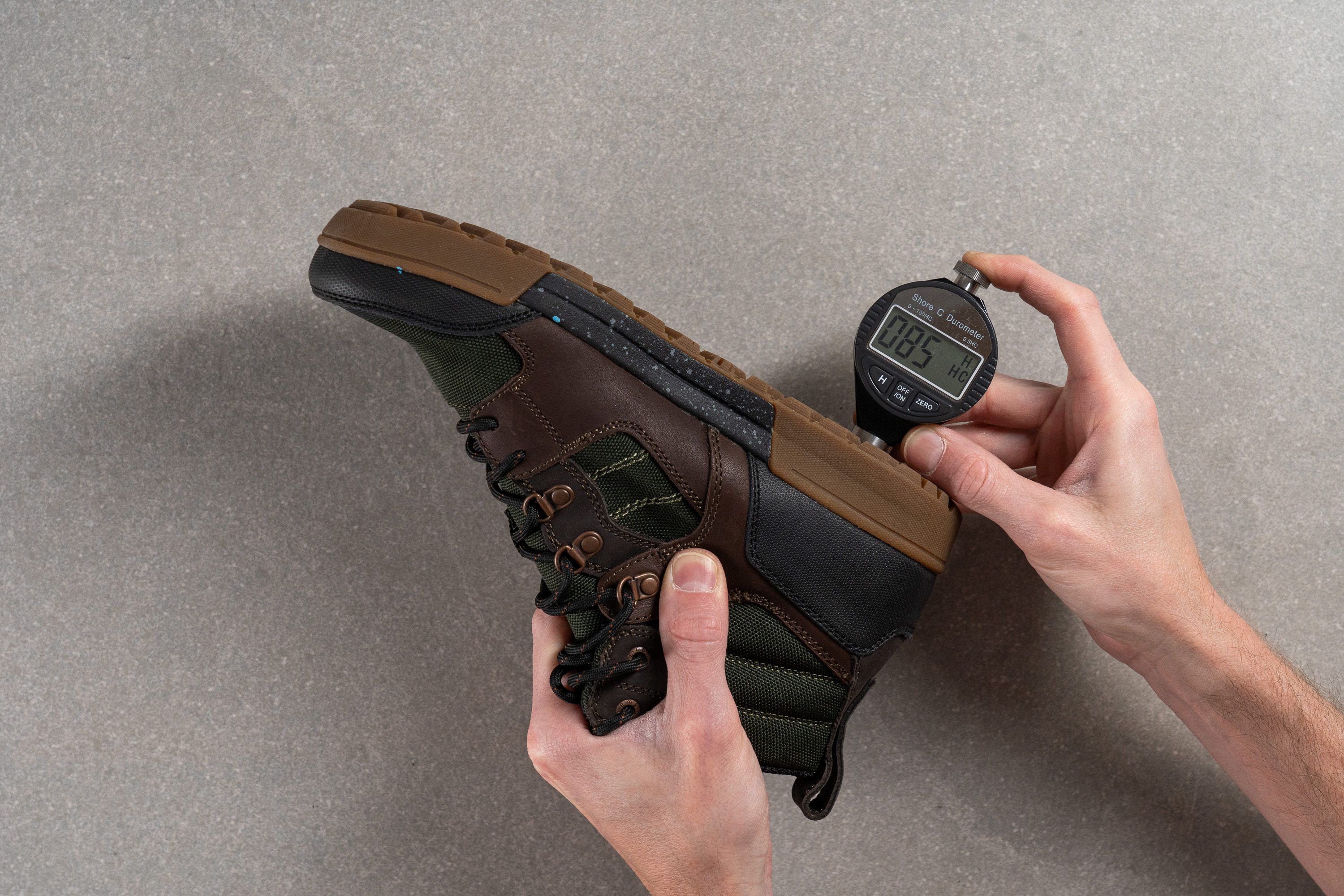
Our Shore C durometer confirmed our initial impression with a reading of 85.1 HC. It is just about the same hardness as the average.
| Outlander | 85.1 HC |
| Average | 87.1 HC |
Outsole durability
Even though it looks like gum rubber, the boot's outsole compound stood up to our durability challenge with flying colours.
After being exposed to the Dremel for 22 seconds at a relentless speed of 10K RPM, the boot's outsole rubber showed an average amount of damage for a hiking boot. Our tread gauge showed a mere 1.0 mm of dent depth.

| Outlander | 1.0 mm |
| Average | 0.8 mm |
Outsole thickness
Our only concern was the thickness of that rubber compound. At only 2.0 mm, it is notably thinner than the average.
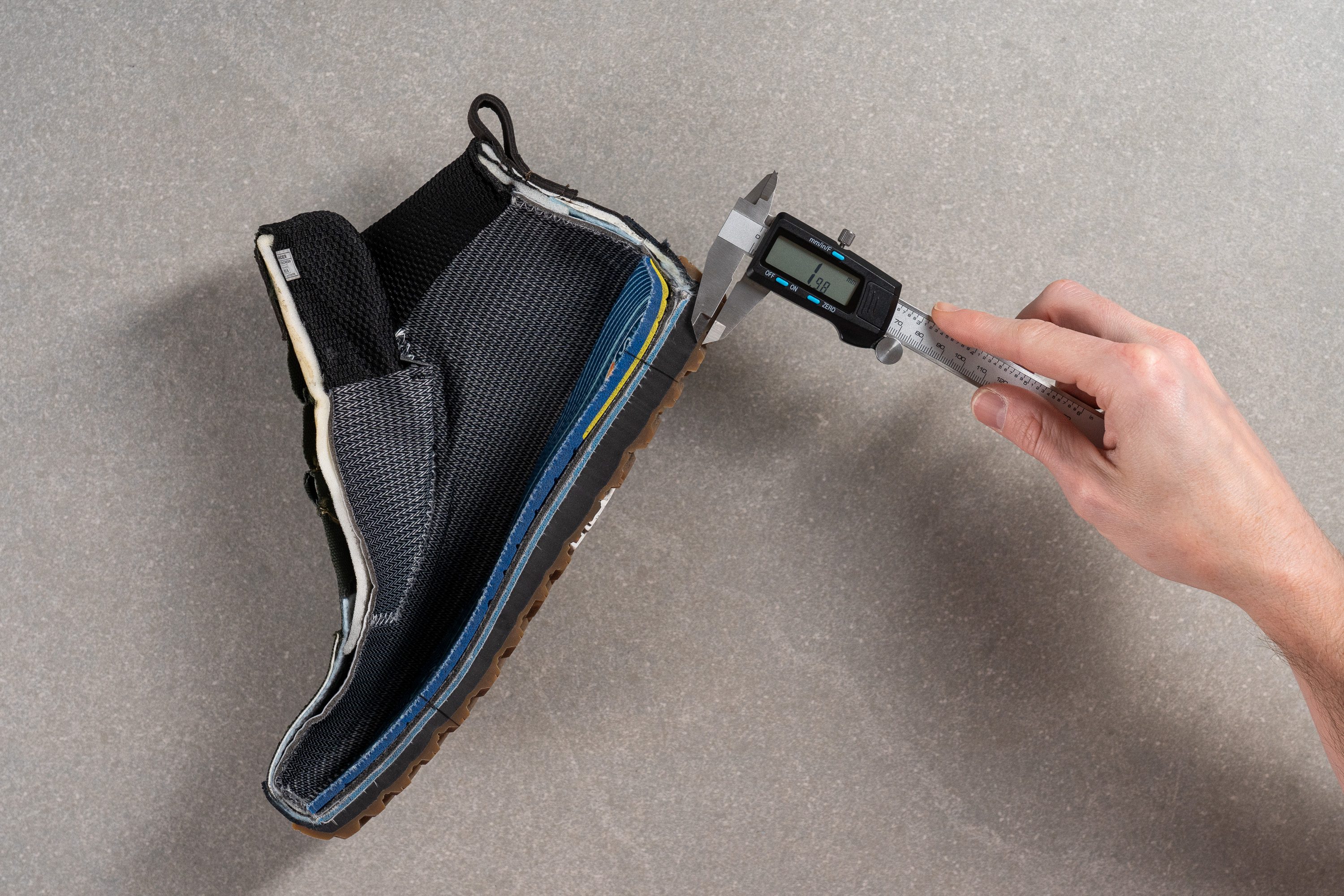
All three tests considered, we believe that the Outlander boasts solid outsole longevity. Even though it is not the toughest outsoles we've seen on hiking boots, it is quite dependable.
| Outlander | 2.0 mm |
| Average | 2.9 mm |
Misc
Insole thickness
The boot's insole is quite generously padded at 7.2 mm in the heel. Surprisingly, the brand's specs say only 5.5 mm. But that's not all we have to say about this curious insert.
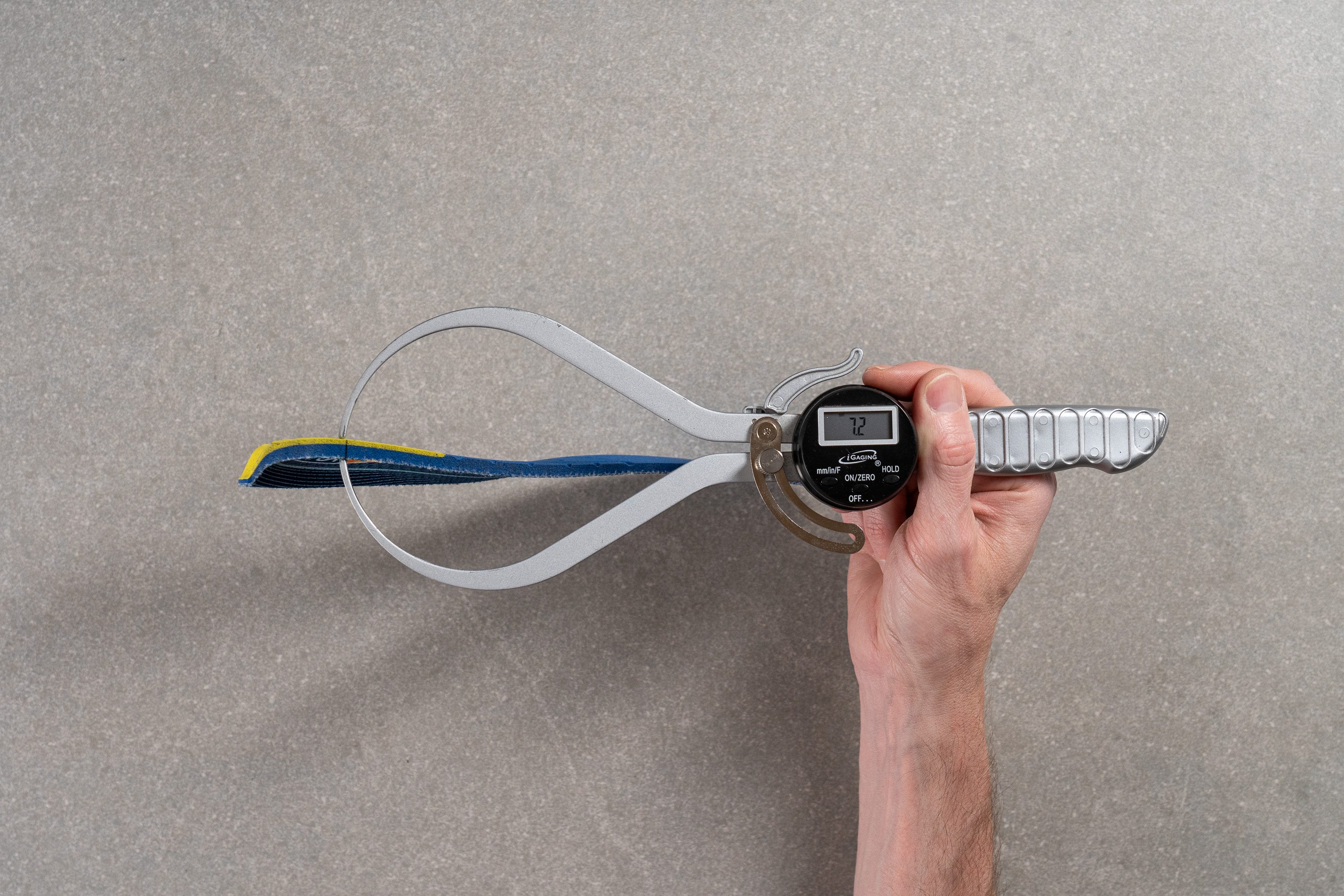
Lems takes foot care to the next level by adding the Adventure Poly Insole to the Outlander. It is softer at the top, firmer at the bottom, and is ergonomically contoured to the foot.

We thoroughly enjoyed the comfort that this insole added to the otherwise firm sole and found that it can even be purchased separately on the brand's website (£20).
| Outlander | 7.2 mm |
| Average | 6.0 mm |
Removable insole
The Outlander's insole is easily removable. You can swap it for a custom orthotic of your own or just take it out for even more in-boot space.

| Outlander | Yes |
Midsole softness in cold (%)
Having a firm sole from the off means that it's going to feel consistent in both warm and cold temperatures.
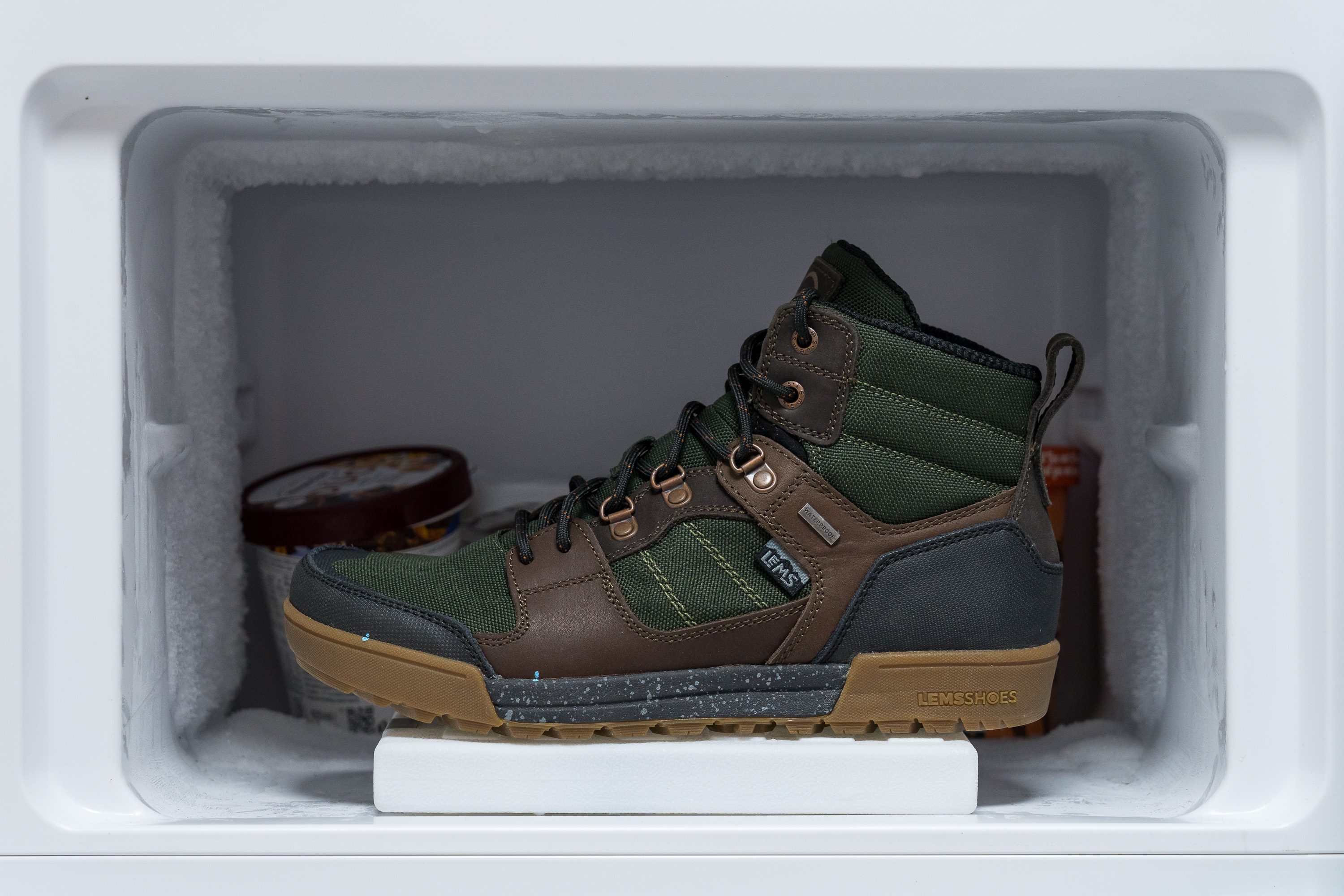
After keeping the Outlander in the freezer for 20 minutes, we discovered that its midsole firmness only changed by 8%. Meanwhile, some plush foams firmed up by a whopping 40-50%!
| Outlander | 8% |
| Average | 20% |
Reflective elements
This Lems boot is not very helpful in low-light conditions as it has no reflective elements on it.
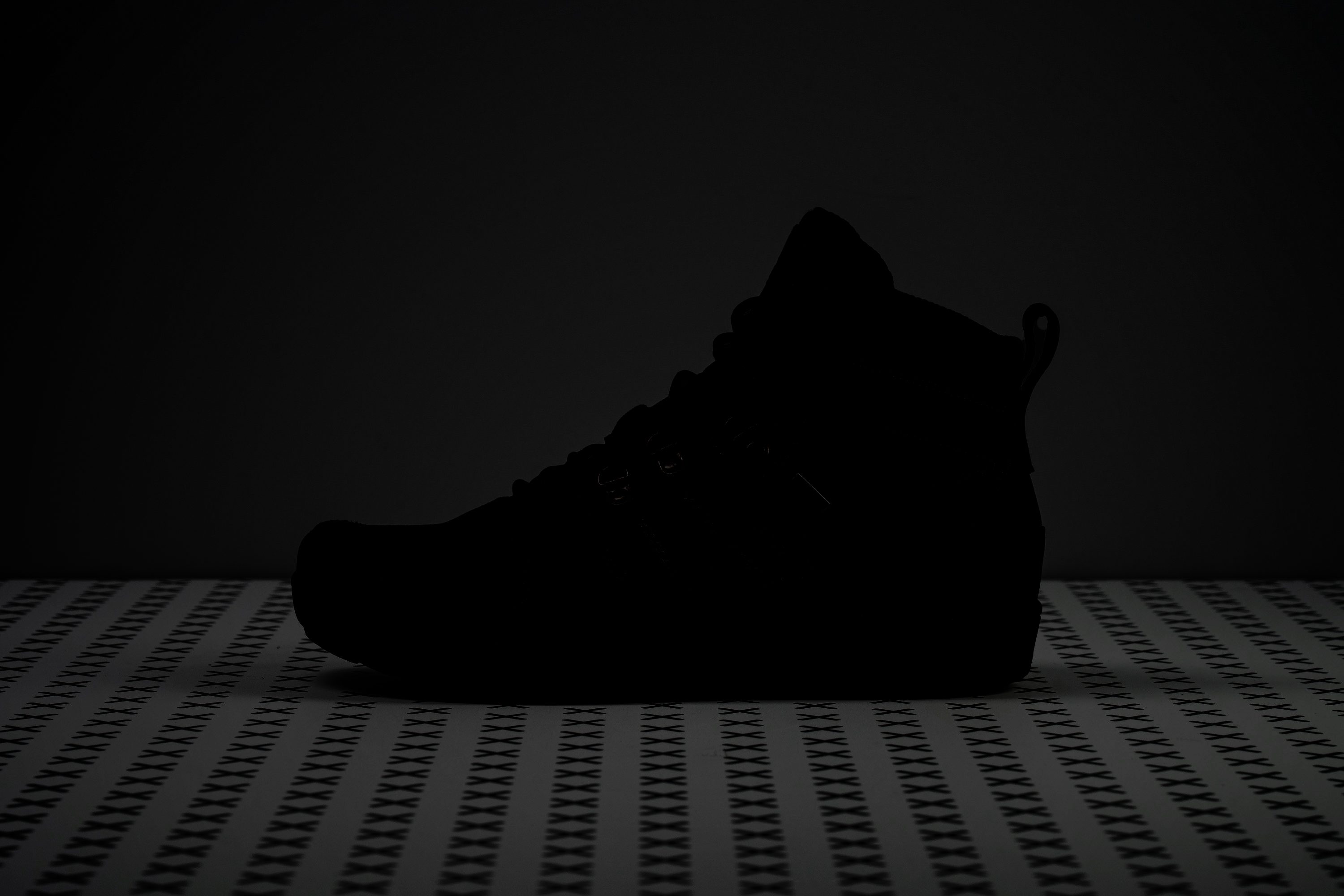
| Outlander | No |
Tongue padding
Despite the Outlander's minimal design, it still packs enough padding where it's most needed. There was enough foam in the boot's tongue (10.1 mm) which protected our insteps from lace pressure quite nicely.
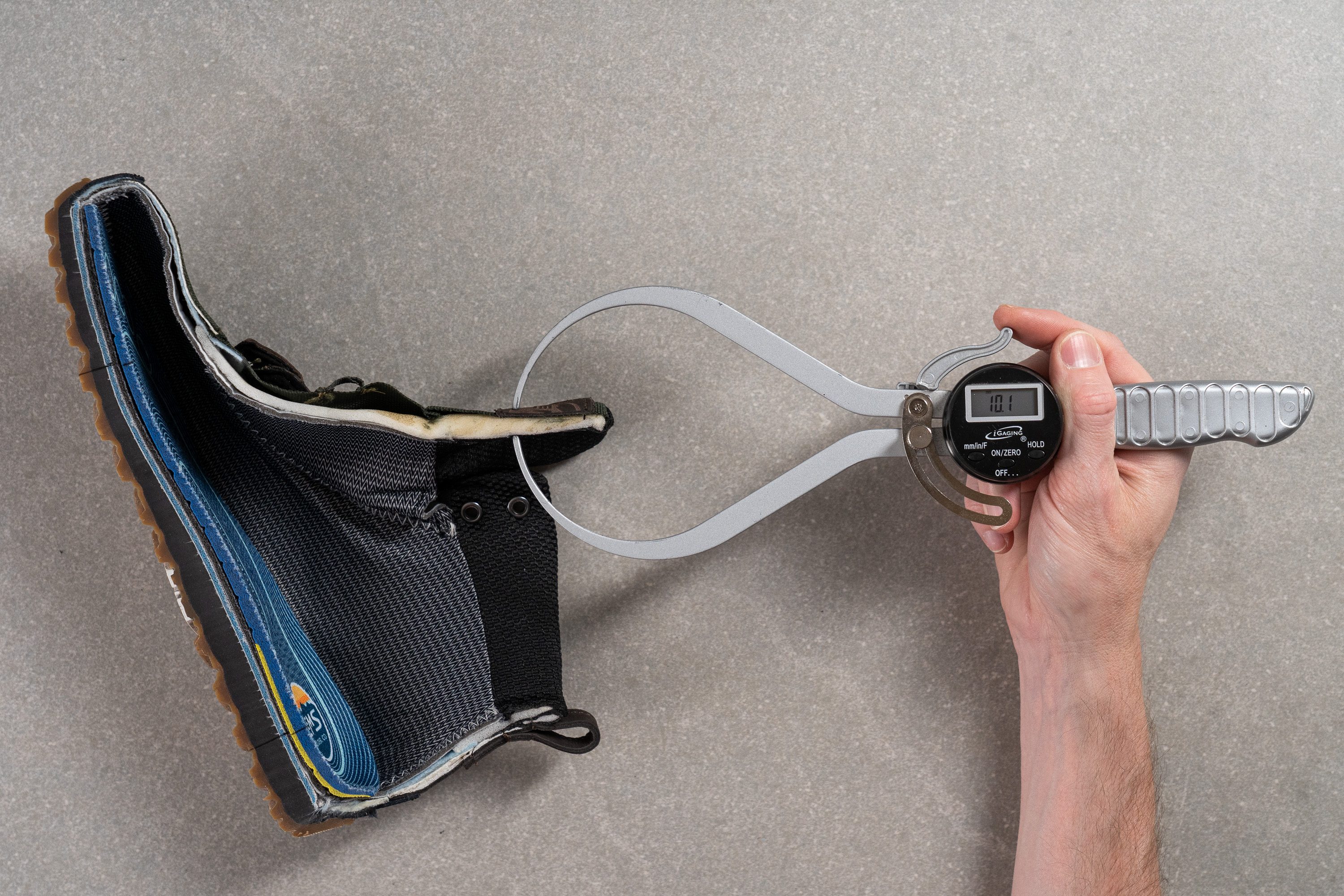
| Outlander | 10.1 mm |
| Average | 11.2 mm |
Tongue: gusset type
A fully gusseted tongue is a must for waterproof hiking boots. We have nothing but praise here as the gussets helped to keep debris and moisture away from the interiors.

| Outlander | Both sides (full) |
Heel tab
A finger loop proved to be handy every time we slipped into this Lems boot. Compared to the frail fabric loops on most shoes/boots we've tested, this sturdy leather design looks quite tear-resistant.

| Outlander | Finger loop |

